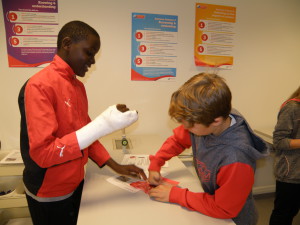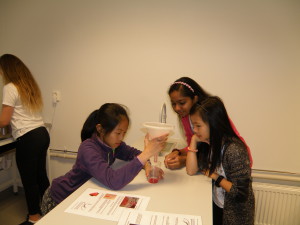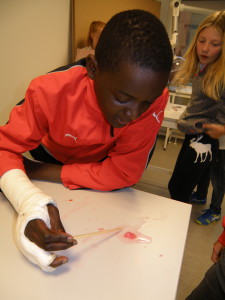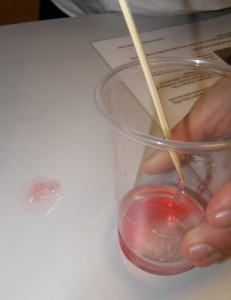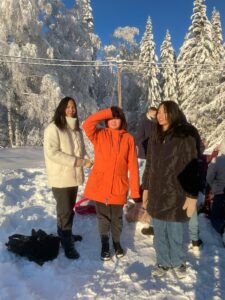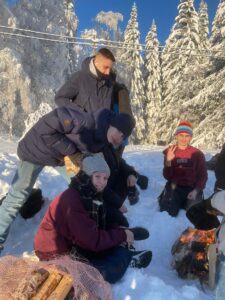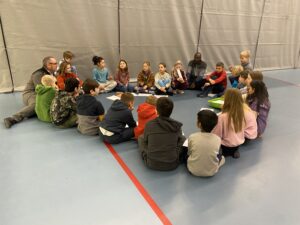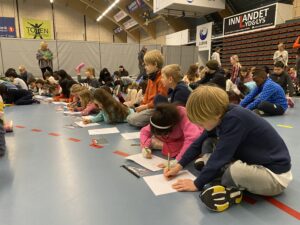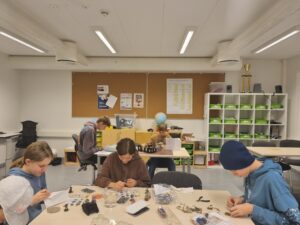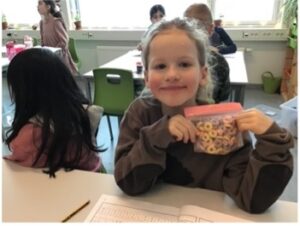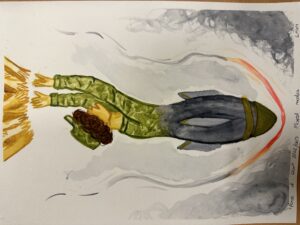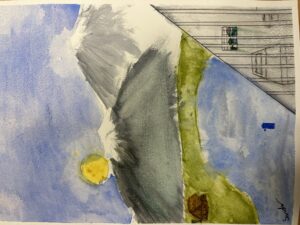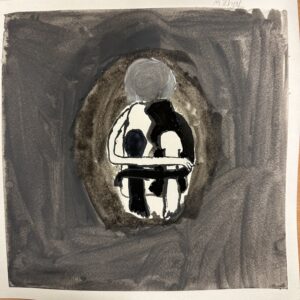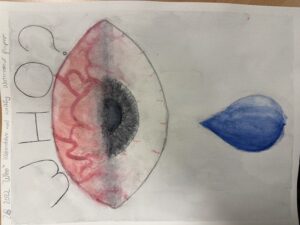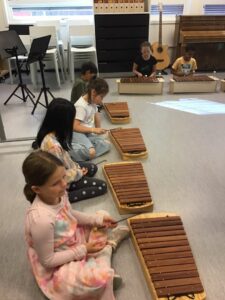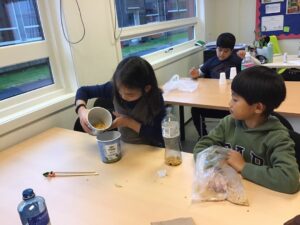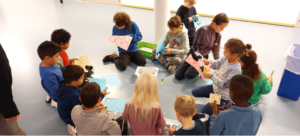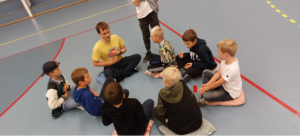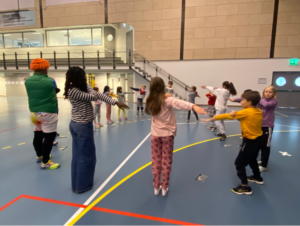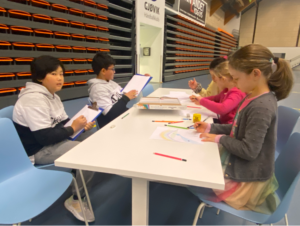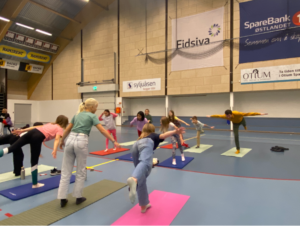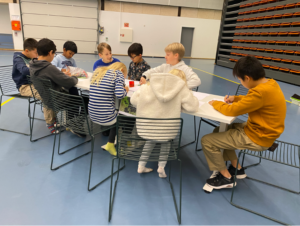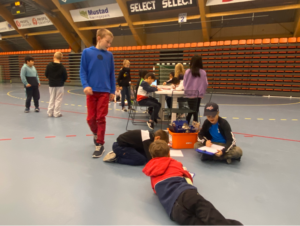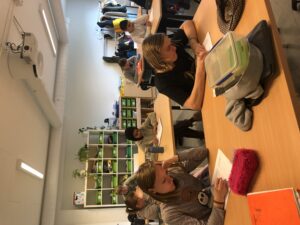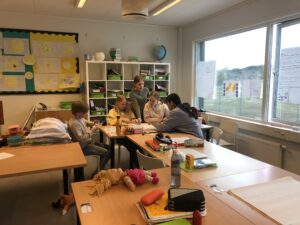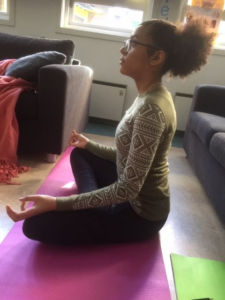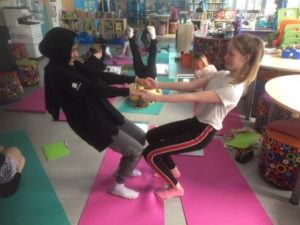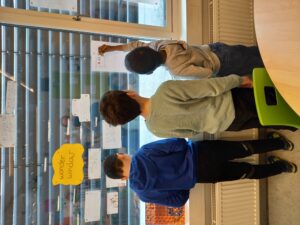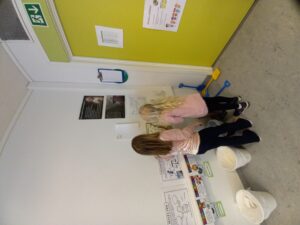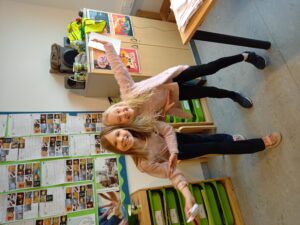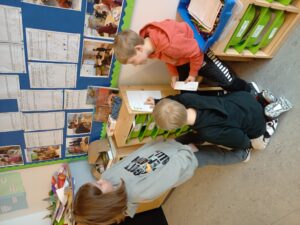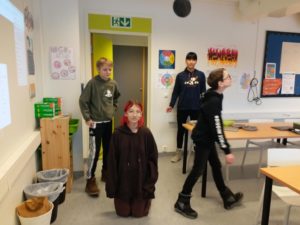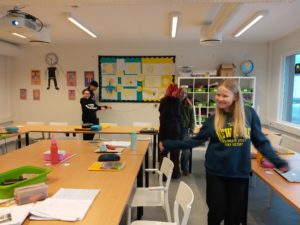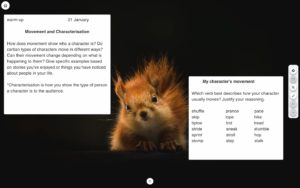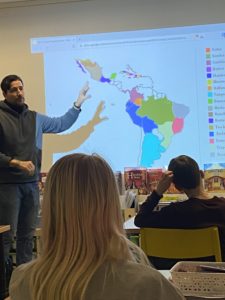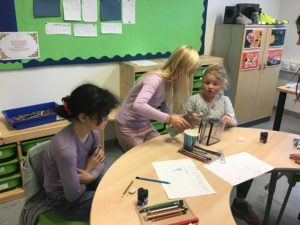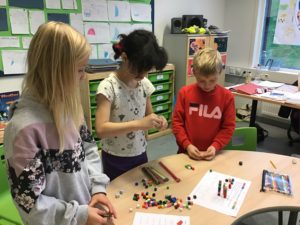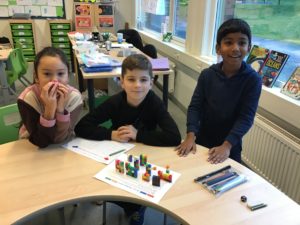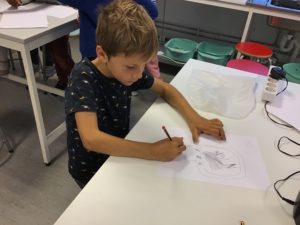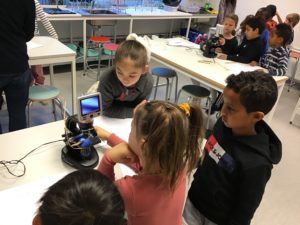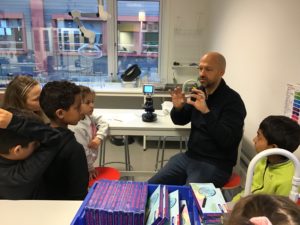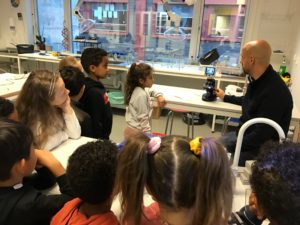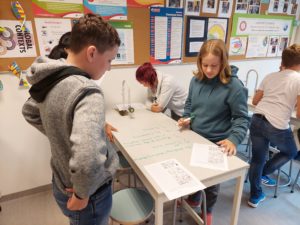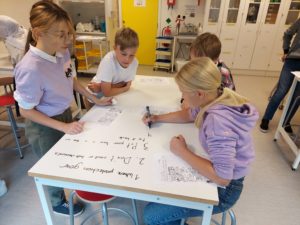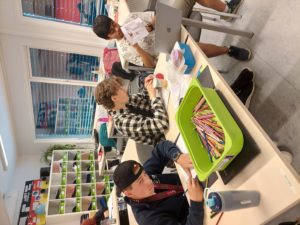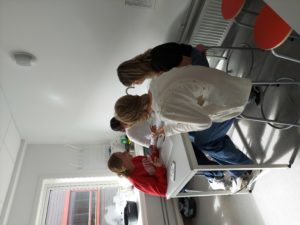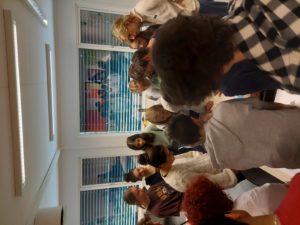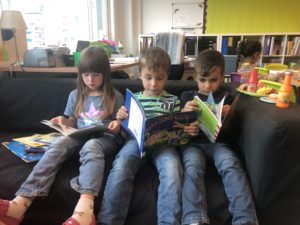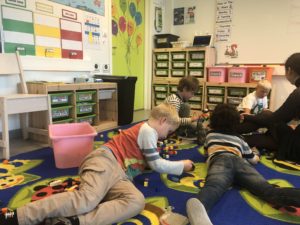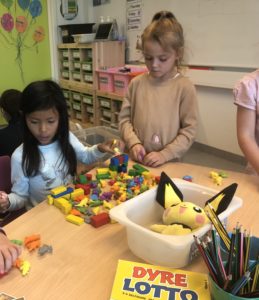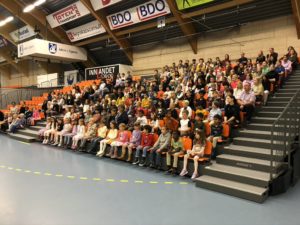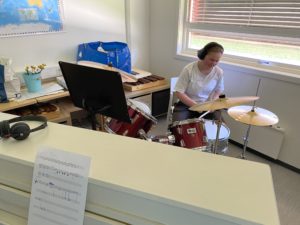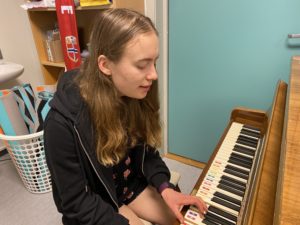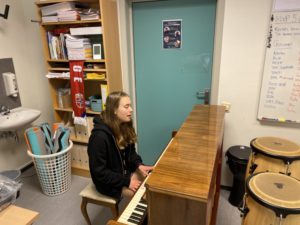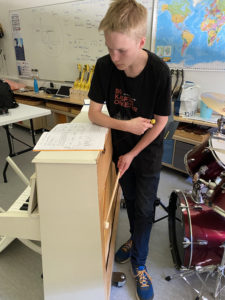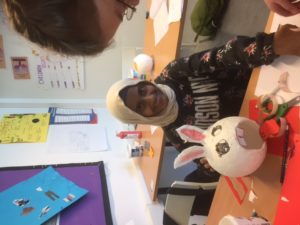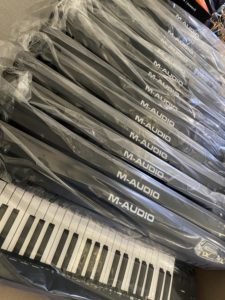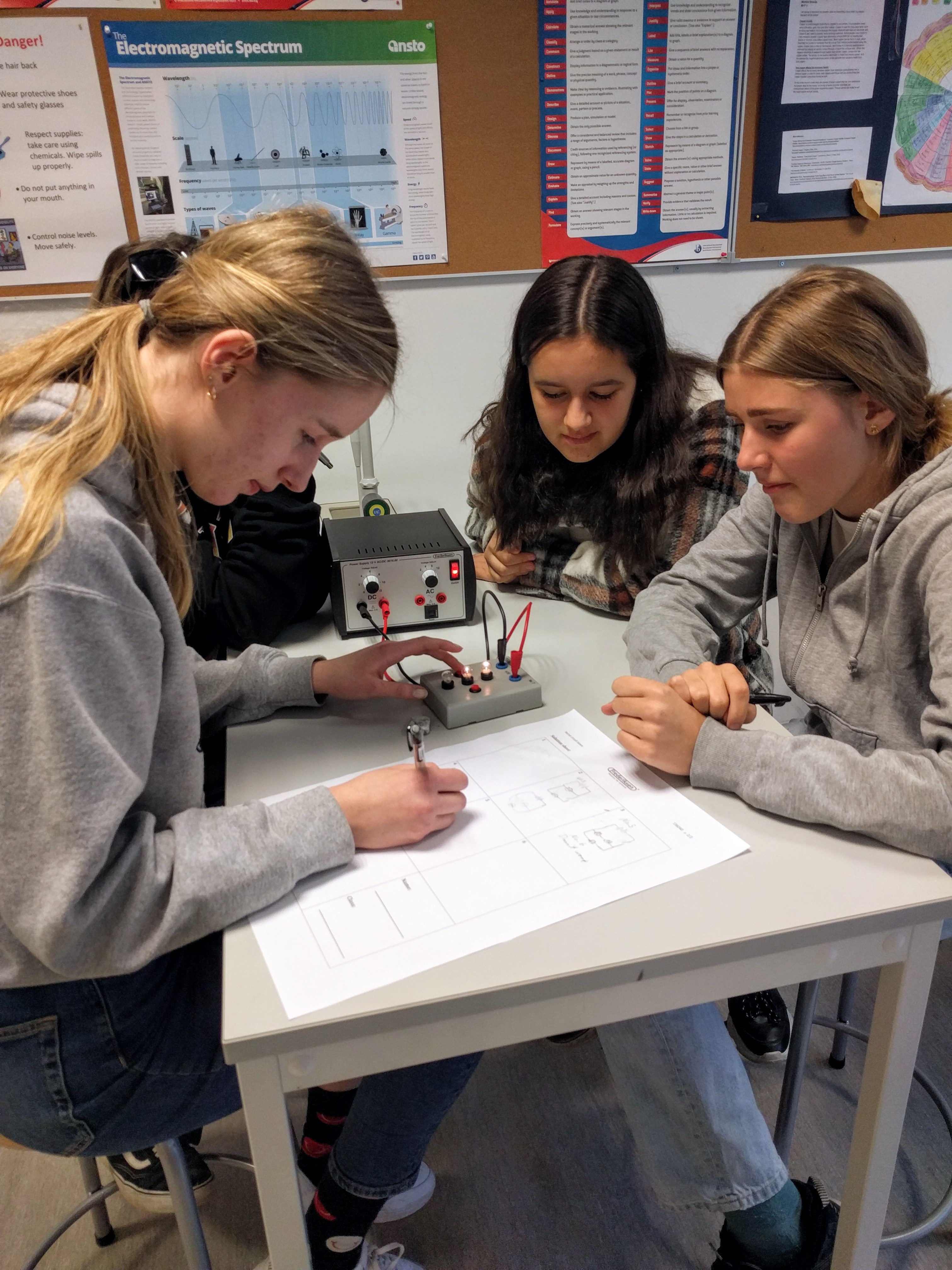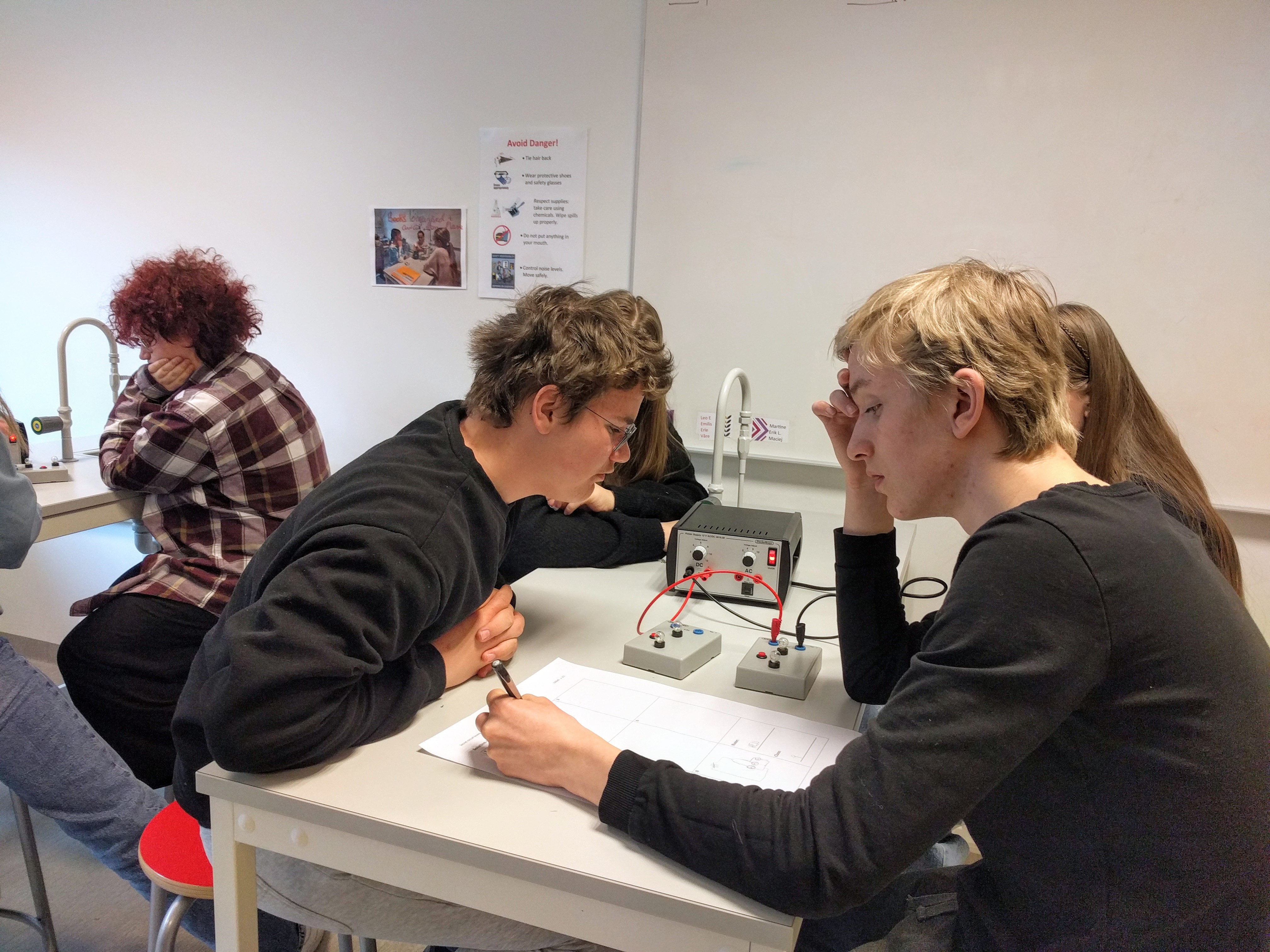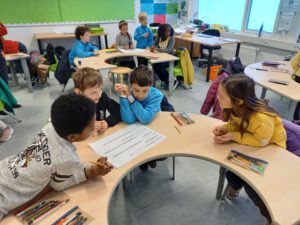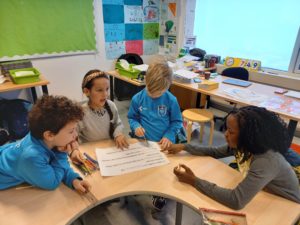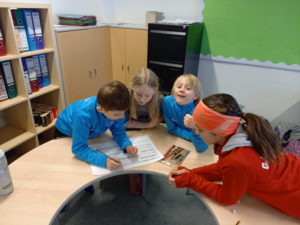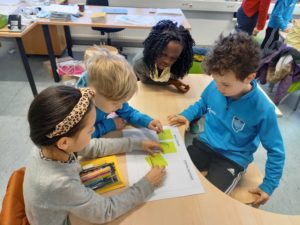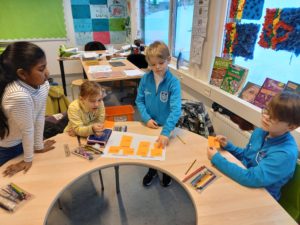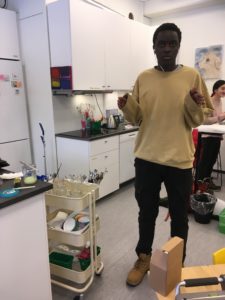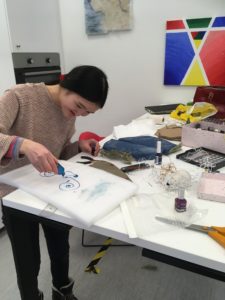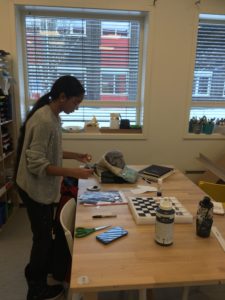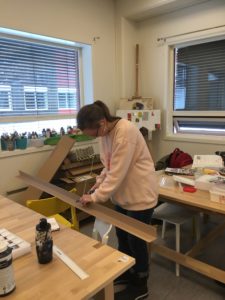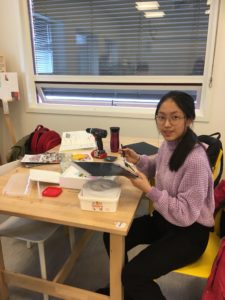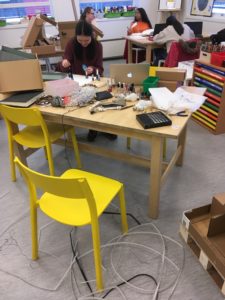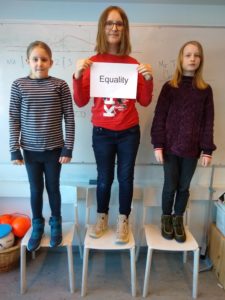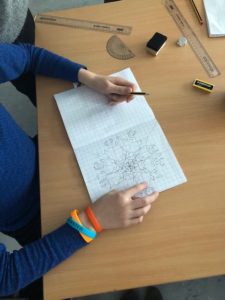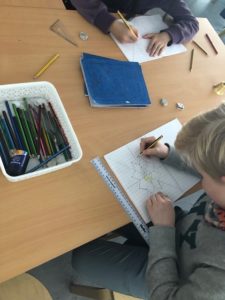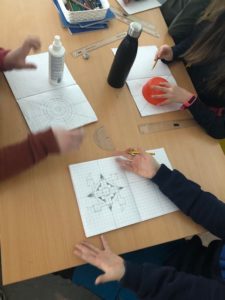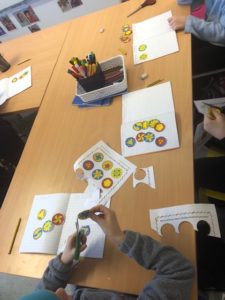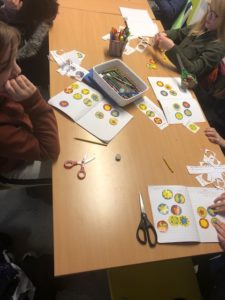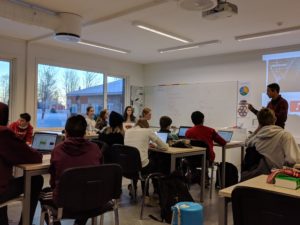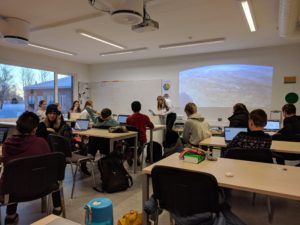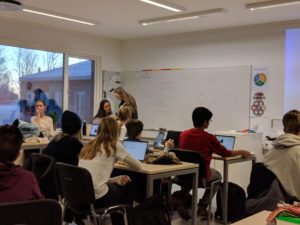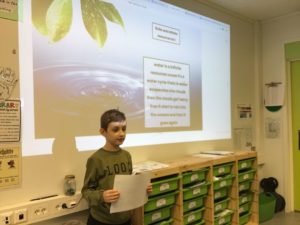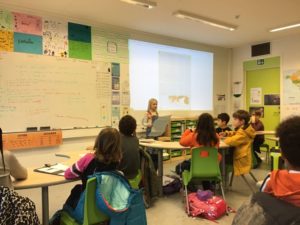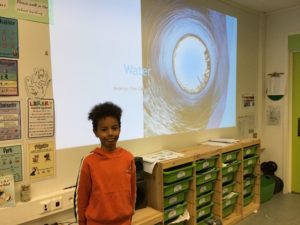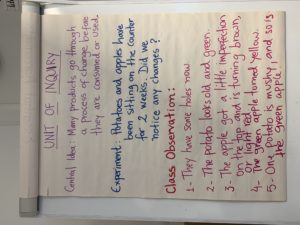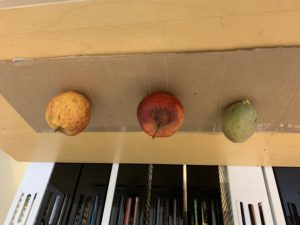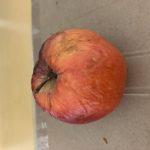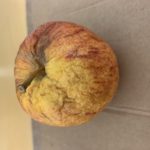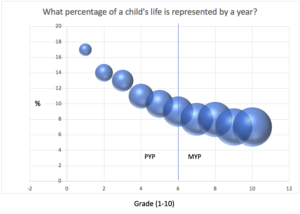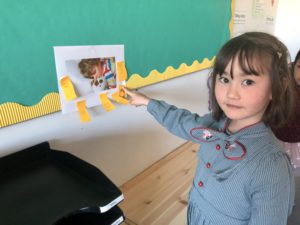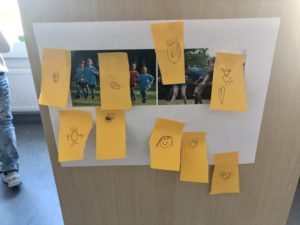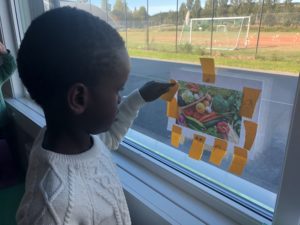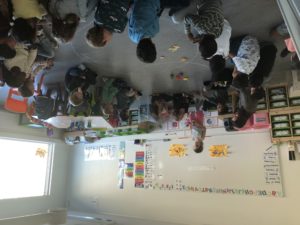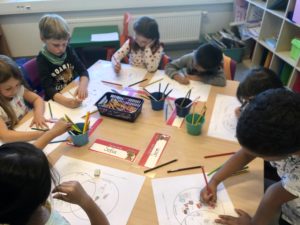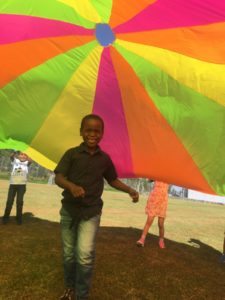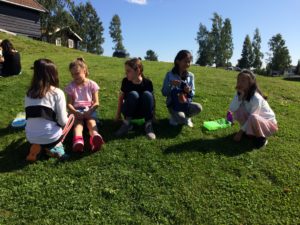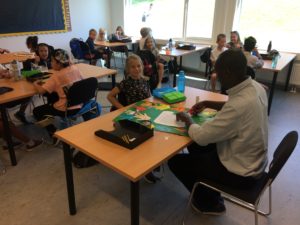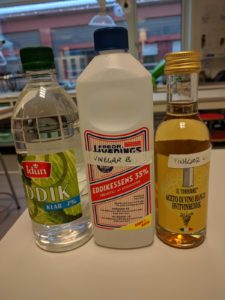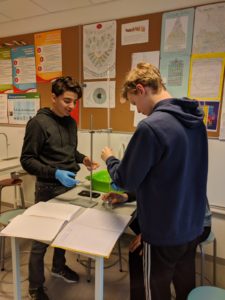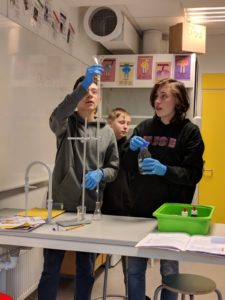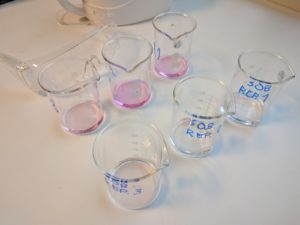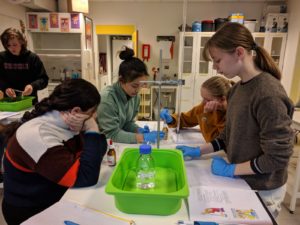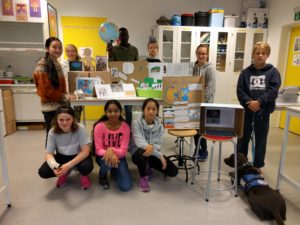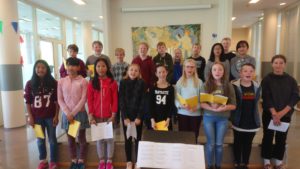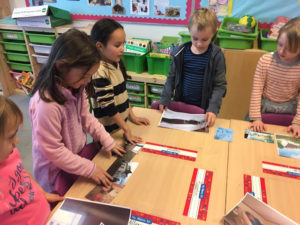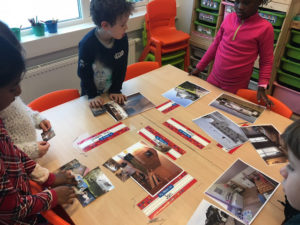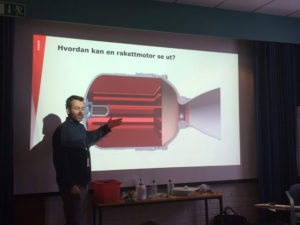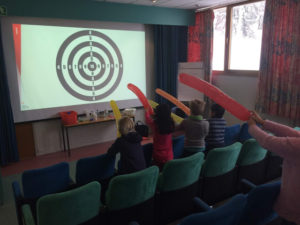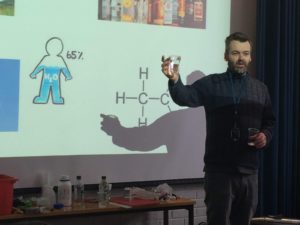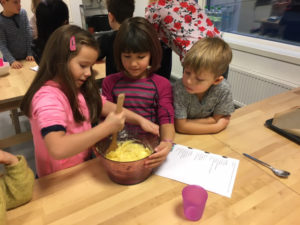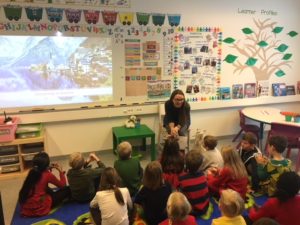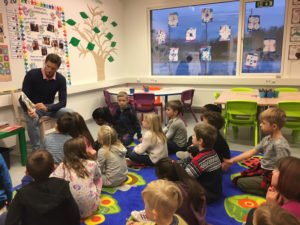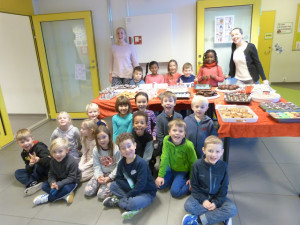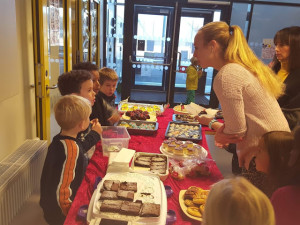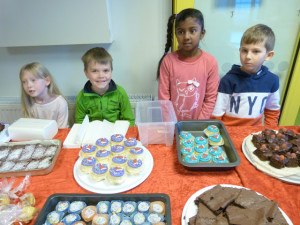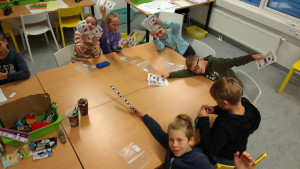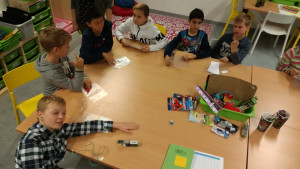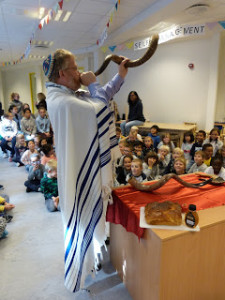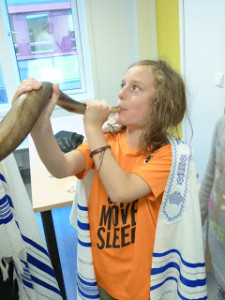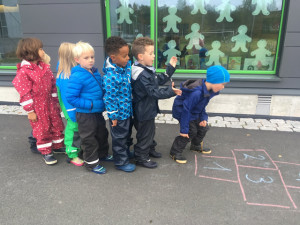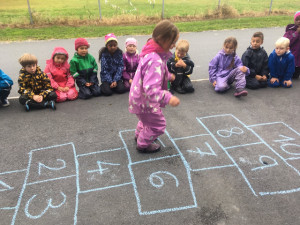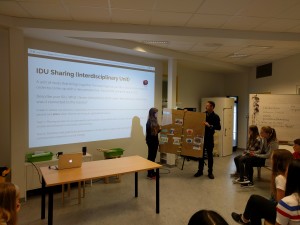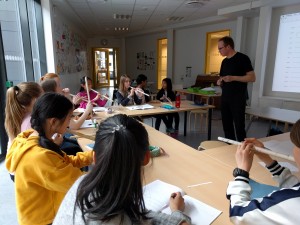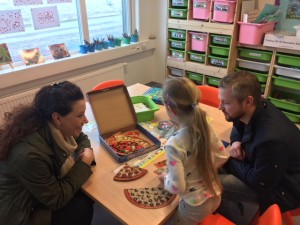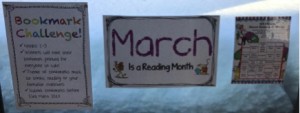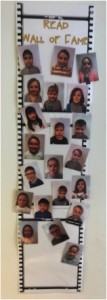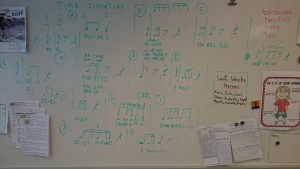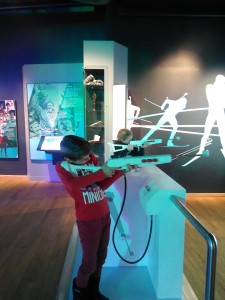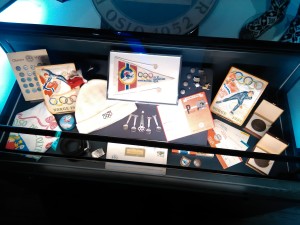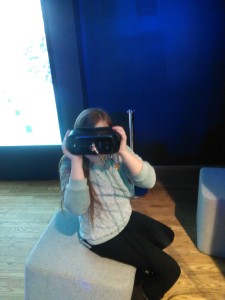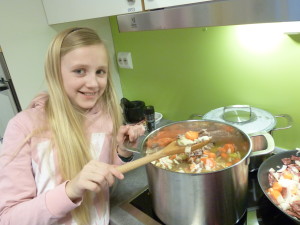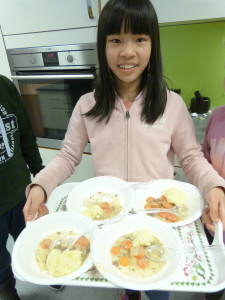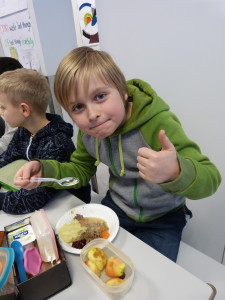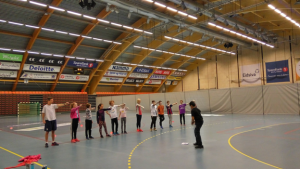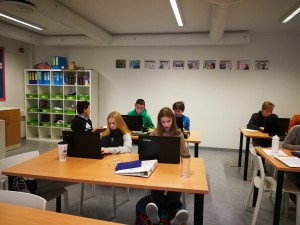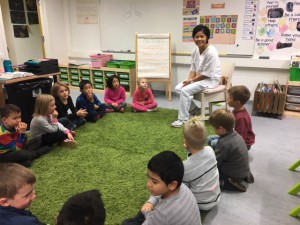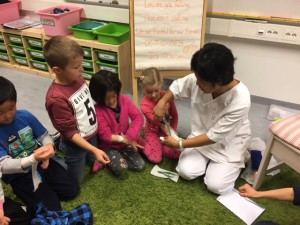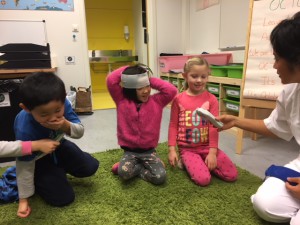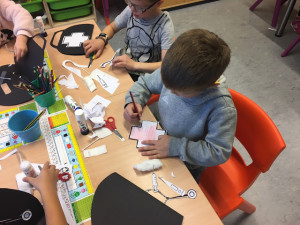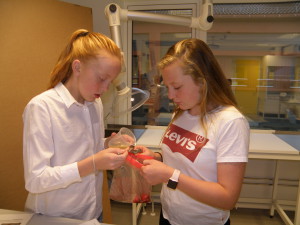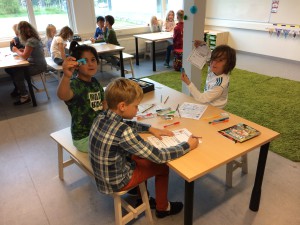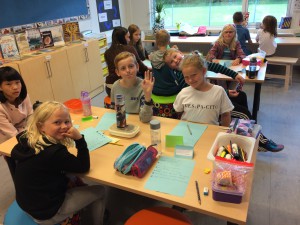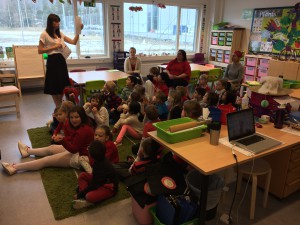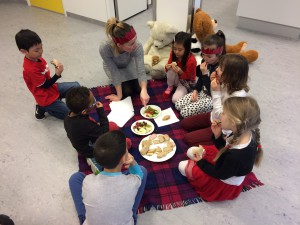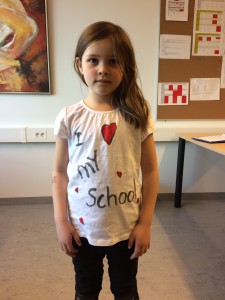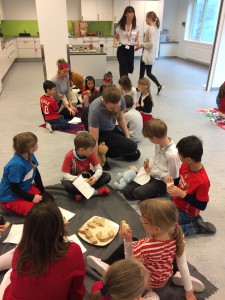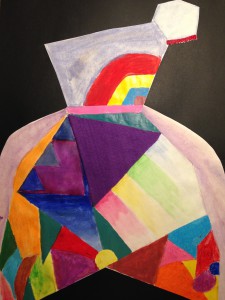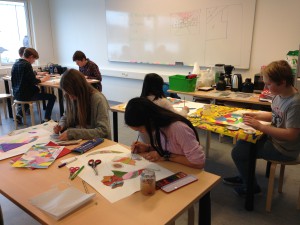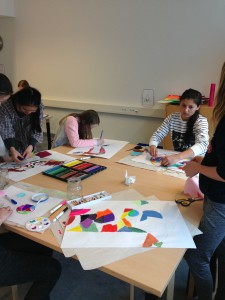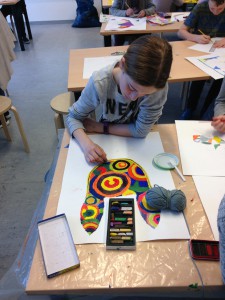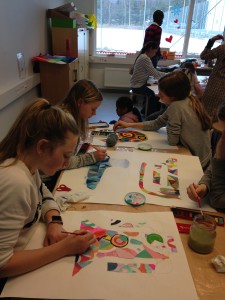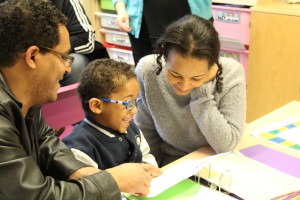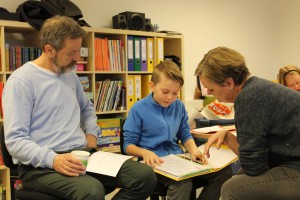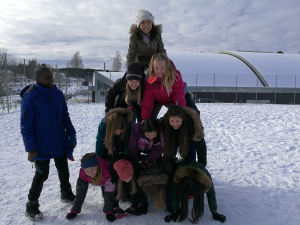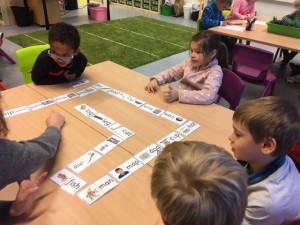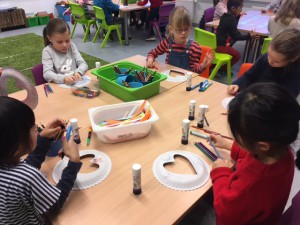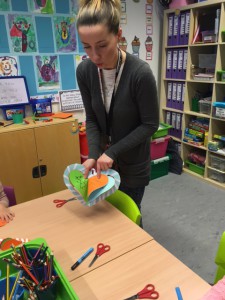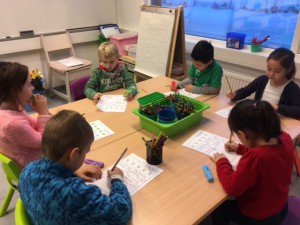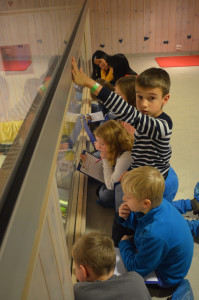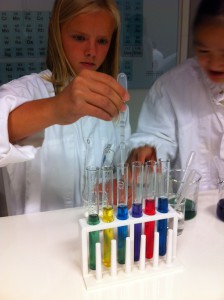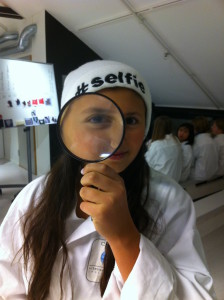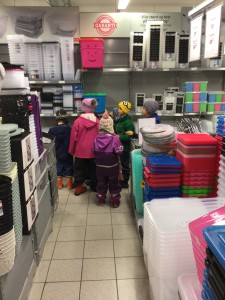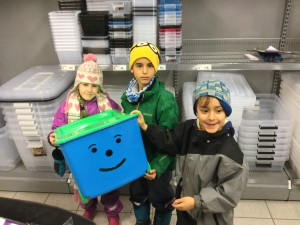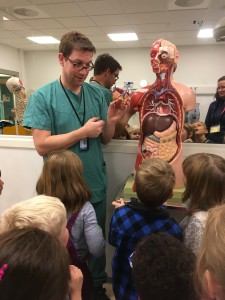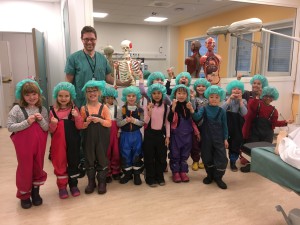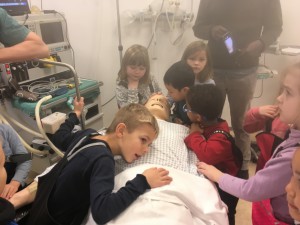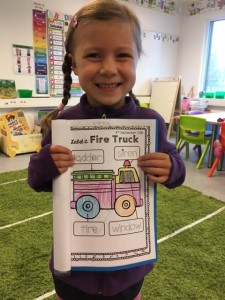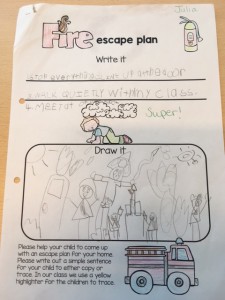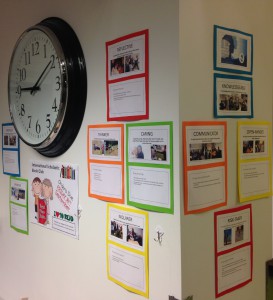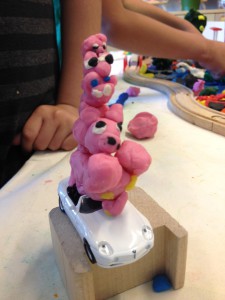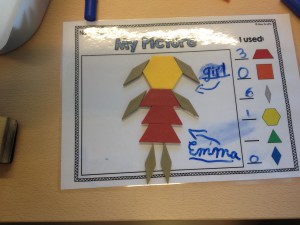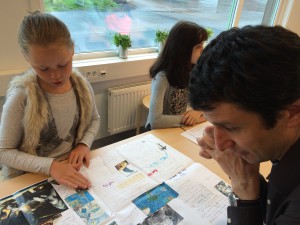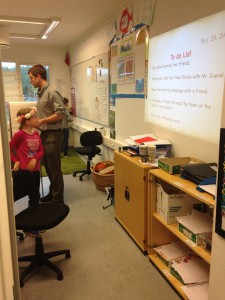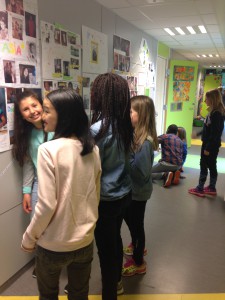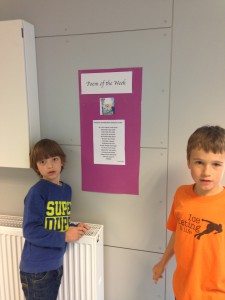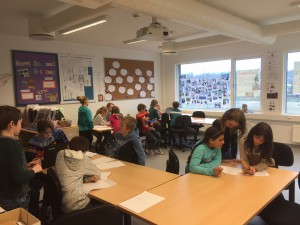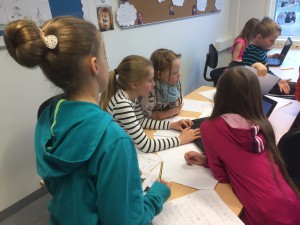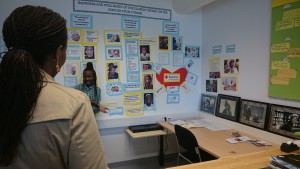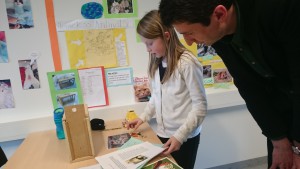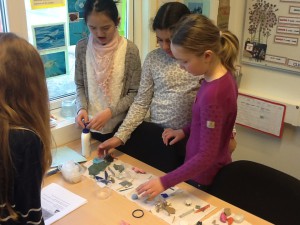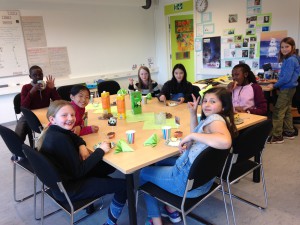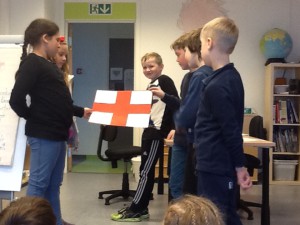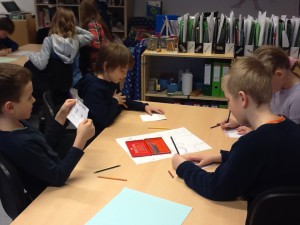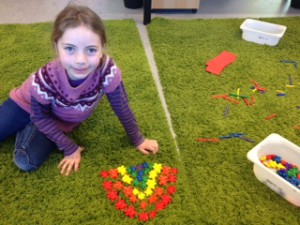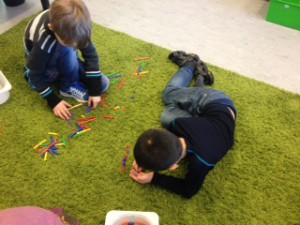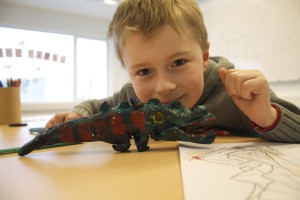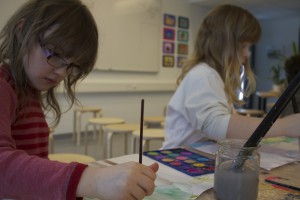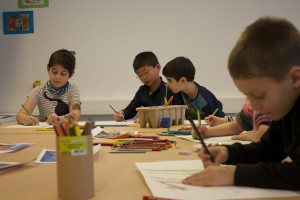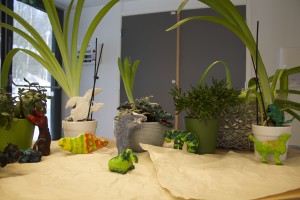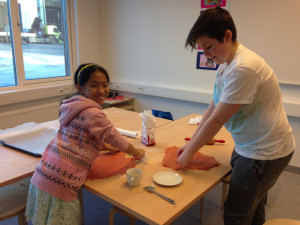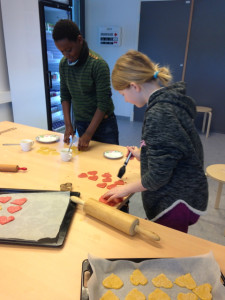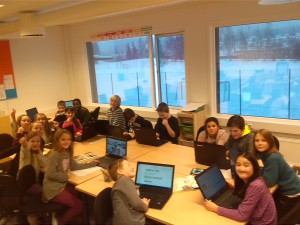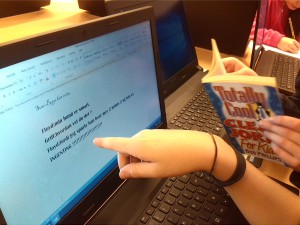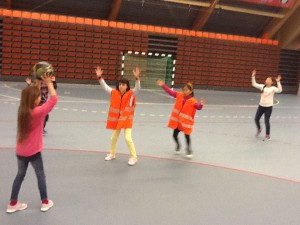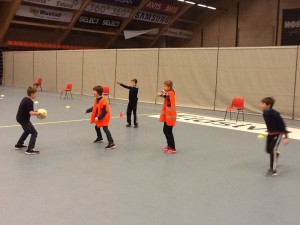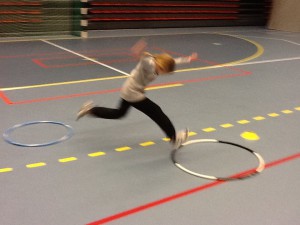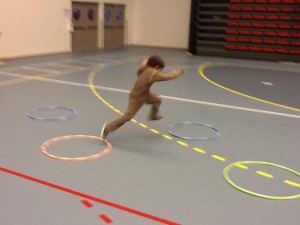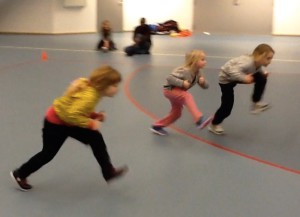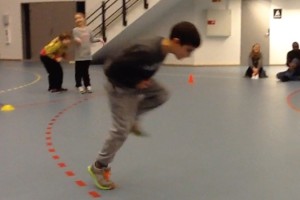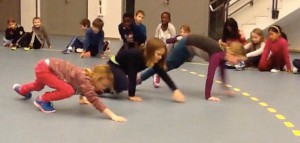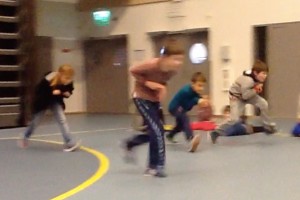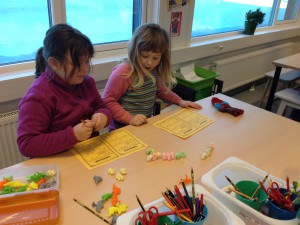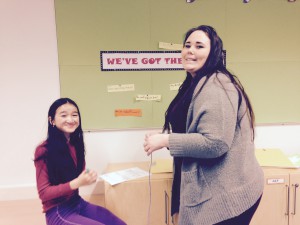Turning Problems Into Opportunities
10 March 2023
Duke Ellington, the legendary jazz musician, once said, “A problem is your chance to do your best.” In today’s rapidly changing world where problems regularly arise, the ability to think creatively is becoming increasingly important. Creative thinking involves approaching problems in a new and innovative way. It requires us to think outside the box and consider alternative solutions. When students are encouraged to think creatively, they become more engaged and motivated learners. They also develop the ability to solve complex problems, which is a valuable skill for success in the future.
Whilst we cannot do this all the time we do try to take as many opportunities as we can to promote the development of these skills through inquiry-based and project-based learning. In doing so our students can turn problems into opportunities.
James Eide-Harwood
Secondary Principal
100 Day
20 February 2020
In grade two we count the number of days we are in school as part of our morning calendar routine. The students created a colour pattern to show even and odd numbers, the numbers we count in the fives pattern, and the numbers in the tens pattern. On the 31st of January we reached the day we had all been anticipating; the day we added one hundred to our number line. From that day on all the numbers we count will have three digits as we include one hundred in our place value pattern. So, to mark this special milestone we celebrate the 100th Day of School.
Children brought in collections of 100 items that they collected and counted at home. There were bags and boxes with collections of 100 Fruit Loops, Lego blocks, beads, assorted colours of grains of rice, coloured sweet sprinkles, bird seeds, puzzle pieces, a peg board with pegs and puzzle building blocks that made the number 100, and fish crackers.
Someone brought in a collection of balloons to help decorate the room and another wrote a list of the ten’s numbers to 100. The children worked on activities that centered around one hundred in numbers and words. Students imagined things which 100 of would make them very happy or upset. Then they worked on pages of number that added up to 100, numbers subtracted that equal 100 and adding other numbers to 100.
Finally, to top off our celebration, Grade 2 students had pizza for lunch. This was a prize for the fine job they did on decorating our door for Christmas, but it helped us celebrate another special day of the school year.
Heidi Brenner
PYP Coordinator &Grade 2 teacher
Understanding “Setting”
24 January 2023
When we work with literature, we talk about the different elements of fiction. One of these elements is “setting” meaning where and when the story takes place. In our current unit in Norwegian, Grade 9 students are engaging with the novel “Tschick” by Wolfgang Herrndorf. The opening parts of this story take place in a less fortunate neighbourhood in Berlin.
To understand what this means for the story, students looked at their reading notes, and compared them with other texts about troubled neighbourhoods. They chose a broad variety of “cultural texts” including photographs, newspaper articles, song lyrics and poems to build their understanding of these types of neighbourhoods.
Based on their newly acquired knowledge, they made a creative output in form of a rap song or song lyrics, which then was performed for the class. Feedback from students was that they learned a lot from studying different texts in contrast, and that they enjoyed the creative task at the end.
Espen Øye Bjørkvold
MYP Norwegian Teacher
Meaning of Art
10 January 2023
«Art grows out of grief and joy, but mainly grief. It is born of people’s lives.”
These words by Edward Munch summarise the type of art Grade 8 students created in their summative task called “Metamorphosis with a Message.” Suffice it to look at a few artworks to understand that the students used the task to share their own life experiences. Deeply personal yet universal messages can be conveyed through metamorphic art. At times, artists just want to play with senses and perception, creating optical illusions. Other times, metamorphic art can confuse and provoke. For Grade 8 students, it became a powerful means of expression, a way to send important messages to the audience.
Lisa chose to create a work called “Force of War.“ She comes from Ukraine. What message about war do you think she was trying to convey?
Sander called his artwork “Mountain and Prison.” Can you see what he tried to say about life?
Jenny created an artwork about time. What message do you think she tried to share?
Molly’s “Blah, Blah, Blah” is most likely relevant to all of us. Can you identify with her thoughts?
Edward was thinking about his personal relationship with his beloved dog while creating his work. Do you feel similar about your pet?
Michal’s work’s title is “Not Everyone Is Perfect.” To what extent does it resonate with your experiences?
And… who do you think is asking the question in Zara’s artwork? Is there a message there?
Grade 8 developed amazing skills in watercolour techniques but, more importantly, they were engaged in this unit and task on a very personal level. This is the power of how Arts are embraced in IB schools and how Visual Art is taught and learnt at GIS.
The IB describes Art in the MYP as a discipline where “students develop through creating, performing and presenting arts in ways that engage and convey feelings, experiences and ideas.” (https://www.ibo.org/programmes/middle-years-programme/curriculum/arts/
Agata Wieczorek
PYP and MYP art teacher
PYP Music
31 October 2022
Here are a couple of snapshots of our activity during these last months. In grades 3/4, student have been researching how we can use music for religious purposes and how to express ecstasy and devotion through music, by playing the Jewish song Debka Håra.
For our new unit, Sharing the Planet, students have been researching how to make recycled music instrument reusing daily materials like cups, cardboard, paper rolls, elastic band and food leftovers–nuts and seeds.
During these days around Halloween, students have been immersed in many different “spooky” activities. The students had fun, playing the “Pass the pumpkin”- a board game, made by them. Whenever they land on a “pumpkin”-space they get to play a spooky song on a Boomwhacker xylophone.
Uri Sala
PYP Music teacher
Peace Day
21 September 2022
As part of the United Nations International Day of Peace for 2022, Grades 5 & 6 harmonised their efforts to lead Grades 1-4 in a Peace Day Assembly. When conjuring assembly ideas, Grades 5 &6 were asked: ‘What makes you peaceful?’ and ‘How might you make others peaceful, too?’
As can be seen from the photos, a whole host of activities were planned, organised and delivered, including mindfulness, yoga, sketching, designing logos for peace and many more. This year’s theme, End Racism, made us consider how we could show diversity with our clothing; we opted for displaying as much colour and vibrancy as possible.
Welcome back!
20 August 2022
Another academic year at GIS is well underway! It has been just a week but we have already settled into our routines. This week has seen hugs and laughter but also some anxiety and tears as first graders embarked on their schooling adventure. A special thank you goes to everyone that made our new students feel welcome. It was a great pleasure to watch returning students taking care of new students at break times.
We are very excited about this academic year. We are planning to continue working on a number of projects initiated last year and before but also start new ones. We will present them to parents at the PYP Meet the Teacher event on 30 August and the MYP equivalent on 1 September.
This year will be particularly exciting for Grade 10 students, who will be deciding where they want to continue their education. Of course, we will support them throughout this journey whatever path they choose to follow. It is rewarding to know that some students feel empowered to look beyond the Gjøvik region. We are certain each student finds a school and programme that will allow them to grow intellectually and emotionally to become active and responsible members of any community they choose to become part of.
We hope the school blog is a window into learning at GIS. Please check back regularly to enjoy the stories of learning that we will share here.
Adam Armanski
Head of School
A Week In the German Classroom
4 May 2022
This interesting week contained many activities for the students, including reading and disguises. Monitoring the progress of learning was another priority and therefore it was time to have a little vocabulary quiz, ensuring that the students can see their progress as well as areas for improvement.
Today, the 7th graders learned new vocabulary about clothing. They practised new words and focused on the use of the right articles by putting together cards with pictures and text. We had interesting discussions and sometimes funny results in the different groups.
Building and repeating plural forms will be another challenging activity over the next few days.
Andrea Weiler,
MYP German Teacher
PYP music
8 April 2022
Here are a couple of snapshots from our daily activities in the music classroom.
Grade 4 students are here seen in deeply engaged in their fantastic creative chaos:
They are researching of the sonic possibilities of daily waste materials. Turning used boxes and cans into instrument is part of a unit which combines African music, percussion instruments and ecological consciousness. Students have used their own instruments to perform pieces which they wrote themselves. This gives them sense of agency.
Grade 3 students are currently exploring the music of South East Asia. In the video below, they are mimicking an Anklung ensemble.
Anklung is a unique style of Indonesian music. Two students are needed to produce a single note, so this is an inherently collaborative musical activity. It is pedagogically appropriate because it encourages students to work as a group and listen to each other with close attention. It is challenging to keep a steady beat during the piece unless one listens carefully to the whole tapestry of notes.
Uri Sala,
PYP Music Teacher
Mindfulness in the MYP
1 April 2022
School can be stressful! Students and teachers alike experience stress on a daily basis. Sometimes it feels like all our assignments and projects are due at once. One of the ways we manage this stress in the Grade 7 is through learning about some stress relieving techniques. We are currently in the middle of a yoga unit for PHE and have been practicing breathing techniques such as “nadi shodhan pranayama”, or alternate nostril breathing, which have been proven to help reduce anxiety in stressful situations. For this unit of inquiry students investigate different poses and the flow leading up to each pose. The best part of the yoga session is always the end, where we take five minutes of relaxation and enjoy the “shavasana” pose. For most of the students, having yoga at school helps them find focus and energize for the remainder of the day. Namaste!
Timothy Mills,
MYP PHE & I&S Teacher
‘Migration’ and ‘Matter and Materials’
10 January 2022
Grade 5 – Migration
Students are currently working on a unit on migration, and during the Norwegian lesson they are watching the film “Flukten over grensen”, a Norwegian film from 2020. The film follows two Jewish children fleeing the Nazis from Norway across the border, to Sweden, during World War II.
The film won the Amanda Prize 2020 for the best children’s film award was also nominated in the the best screenplay by Maja Lunde.
Next, we continue analysing and working with issues related to the film and the topic of migration.
Grade 3 – Matter and Materials
For their unit on Attributes of Matter and Materials in the Environment, the Grade 3 pupils have been learning about different materials and their properties, and how the properties can change depending on different conditions.
During this Norwegian lesson, they had fun activities trying to solve several word puzzles and word games relating to the topic of inquiry in small groups.
Nina Haavi,
PYP Norwegian Teacher
(Still) Sharing the Planet with Grade 6
23 February 2022
One of the truly exciting elements of inquiry-based learning is that it can be unpredictable. The approach is student-centered and, since no two children, two classes, or two units of inquiry are alike, the outcomes can be quite varied. I will use elements of our current unit to illustrate just how these differences can play out.
Generally speaking, grade 6 students have initiated similar inquiries under the transdisciplinary theme of Sharing the Planet, for the past three school years. Each time, we have followed lines of inquiry around the same central idea of how the distribution of wealth affects communities and individuals’ access to equal opportunities. Yet, student passions led us in distinctly different directions each time.
During one of the previous years, student interest focused mostly on the different types of government and very little on the economic systems they employ. They showed a greater interest in the relationship between wealth and power at the top, than they did in access to resources at the bottom. So, in the end, Sharing the Planet was an inquiry into government and power for them.
Another group’s inquiry took them in an entirely different direction. Their fascination with the distinctions between the concepts of equity and equality resulted in many lively class discussions and, eventually, directed them toward a collective focus on the challenges associated with the distribution of wealth to individuals. For them, Sharing the Planet was an inquiry into what is fair.
Right now, our grade 6 students are at the end of their inquiry into how the distribution of wealth affects communities and individuals’ access to equal opportunities. They, too, have chosen a unique path. Although they were interested in the distribution of power across various forms of government and the equitable distribution of wealth among individuals, they were more inclined to discover as much as they could about human rights, regardless of their relationship to wealth and power. For them, Sharing the Planet has been about justice.
I have this old Betty Crocker cookbook from the 1930s. In it, there is an entire section devoted to desserts. One of my favorite dessert recipes in that book is for fruit cobbler. The recipe and the steps are the same, regardless of the fruit you choose–the real difference is in the result. A cherry cobbler will look, taste, and smell quite different from a peach cobbler because, in the end, each cobbler is unique. Student-centered learning is like that. You may start with the same inquiry, but when you mix in students who have different interests, the result will be something altogether unique.
Eric Toohey,
Grade 6 Homeroom Teacher
Movement and Characterisation
10 January 2022
Grade 7 English Language and Literature students have been studying characterisation within books and films in the Fantasy genre. Using the novel and film of Howl’s Moving Castle as mentor texts, students’ ultimate goal for the unit is to create their own Fantasy characters and present them in both written and audio-visual texts.
This unit also presents a great opportunity to incorporate a cornerstone of English Literature – Drama! Today, students focused on how movement contributes to characterisation by engaging in a Character Walk. When given quickfire prompts to “walk like a toddler” or “walk like a lion hunting its prey” students must instantly change how they move around the classroom in a way that matches that character.
This fun, kinaesthetic activity enables all students to conceptualise an idea that can be abstract for students whose frontal lobes are still growing: that a wide array of small details contribute to how we interpret a character in a book or film. While they are using these details to create Fantasy characters, they can also reflect on how we build our own characters through how we choose to move, act, and speak through our world.
Sorcha Sills,
Special Educational Needs Coordinator and MYP English Teacher
Celebrating Differences
10 January 2022
Grade five has been exploring different cultures around the world. After thinking about what makes up a culture, students made connections about their individual culture. Before the holiday break, they discussed food, clothing, religion, music, where they live, languages they interact with, ancestors, hair styles, and name meanings. Students read stories about how Christmas is celebrated depending on the country and traditions. Recently, they observed photos of people in traditional clothing and determined their idea of where the people were from. Students later compared and contrasted two cultures’ traditional clothing and potential factors as to why certain areas use different materials. In music class, students are learning about the similarities and differences of music styles and instruments across Latin America. Students’ curiosity peaked when learning about the types of superstitions around the world during New Years which ignited further discussions and an art lesson.
While exploring a range of cultures, students are practicing using respectful language to describe things that are unfamiliar. “It is not weird, it is different.” is a phrase that helps students use kind language while learning new information.
Perrin Thomas,
Grade 5 Teacher
Mathematics in a real-world context
6 December 2021
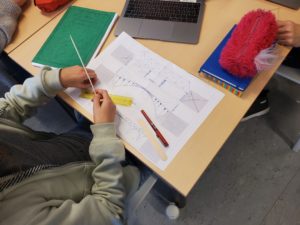
I have taught many different Mathematics curricula in many different contexts. They vary wildly in their content, the mathematical tools and techniques, that are taught. In Asia, where I have spent most of my career, the level of mathematics taught is much higher than in Europe. I remember, in India, teaching content that I didn’t learn until university to 14- and 15-year-olds.
In the beginning I struggled with this because no matter how hard I tried I could not get the class to understand or apply this high-level maths. Eventually, upon talking to the local teachers, the reason became clear to me. I found that the students weren’t expected to use or understand the mathematics, just to memorise and copy and paste the information into their tests. What I saw was that on the surface the students appeared to have very strong mathematical knowledge, however they could not work out how to use the mathematics in any context other than an exam paper. Worse than this, there were very few students who had a passion for mathematics, who enjoyed maths classes and as a result many who had the potential early on told themselves “I just can’t do mathematics”.

Teaching mathematics in IB, thankfully, follows a different approach. Like many other subjects there is a strong focus on the application of knowledge to the real world. The most common questions you hear from students in a maths class often are “Why are we learning this?” or “When am I ever going to use this?”. I remember hearing answers to this in other contexts such as; “You will need this when you are older” and “If you want to be a doctor or a scientist you have to know this”. Not very satisfying answers for most of the students in the class. At GIS we focus on teaching that is relevant for the here and now, as well as the future, and developing skills that cross disciplines and help students with different aspirations.

This year at GIS the units we have covered in MYP where students have inquired about applications of financial mathematics, geometry to redesign layouts of buildings and build bridges, communicating about the statistics of resource consumption, simulating real world situations with mathematical functions and much more. The processes of investigating patterns and communicating using mathematics are skills that I believe are needed every day. As we are coming to the end of the term now the students are the ones that are coming to me with ideas of what they can and want to use the mathematics for. So next term I will be looking forward to seeing how mathematics can be applied to speed running computer games, theoretical physics, musical instruments and more.
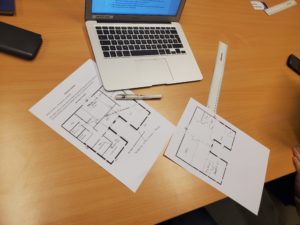
Samuel Rowe,
MYP Coordinator & MYP Mathematics Teacher
Grade 3 – Sharing The Planet
19 November 2021
Grade 3 has been recently exploring how our planet has limited resources that are unevenly distributed. We have explored the difference between renewable and non-renewable resources, focusing particularly on water and how it is unevenly distributed across the Earth. Over the course of our unit, the students have also explored the question of how much water can we actually use. They started off with their ´prediction vs. reality charts´, followed by ´a drop in your cup activity´ in order to find out how much fresh water there is actually on Earth. Apart from that, we have also looked at two case studies that provided us with some detailed information about the water crises in California and Cape Town.
We started off this week with making our own biodegradable plastic, a little experiment immensely enjoyed by all students. Next week we are planning on focusing on water filtration; therefore, we are all looking forward to our ´water filter science project´.
Michalina Baran
Grade 3 teacher
Working with New Tools
5 November 2021
There are times in our units of inquiry when an opportunity arises to take us in a new, unplanned direction. This year our first unit of inquiry offered us such an opportunity and our MYP science teacher was more than willing to help us. Thank you, Mr. Harwood.
During our unit which included the concept of process, we looked at how we use the barley plant. Mrs. Toohey brought barley stalks into the classroom for us to work with. Students learned about the parts of the plant and started the processing of these plants by separating the seeds from the heads of the stalks. Growing amongst the seeds are awns which look like little stalks.
The children noticed that the awns would stick to their skin and clothes. This led to a new inquiry; why did the awns stick to us? And how could we find the answer to this question? Arrangements were made for the students to go upstairs to the science lab. Our science specialist then showed the tools we could use and how they work. Students used magnifying glasses to look at various objects, including each other, around the room. They then used microscopes to look at the awns under higher magnification. The children were invited to draw what they saw on a piece of paper.
What they found was that the awns have little hooks or barbs on them which get caught on our skin and clothes. Further discussion led us to realise that the awns were protecting the seeds so they could grow safe from predators.
After our little investigation in the science lab, students continued on their inquiry into the process of threshing the seeds, winnowing the chaff from the seeds and using the seeds for make food.
Heidi Brenner
PYP Coordinator and Grade 2 teacher
25 Days
17 September 2021
On August the 16th, the European football had ended, the Olympic games in Tokyo had just finished and our big event was just about to begin. After a long summer, we as a community were looking forwards to getting back into our classrooms and continue our educational journey. We have now been at school for 25 days and since we have returned each of us will have completed nearly 160 lessons, your teachers have on average walked a little over 4km per day in the classrooms and your hair will have grown nearly 2cm! Your classrooms are full of energy and excitement. Whilst some of you may not think that you have achieved a great deal the school is adorned with student work showing off our best. Well done and keep it up!
James Eide-Harwood
Secondary Principal and MYP Science teacher
A Flying Start
13 September 2021
Grade 1 has got off to a flying start. All students are buzzing with excitement and all bubbling with curiosity and very excited to do some ‘real’ schoolwork. For most, this is their first time learning across multiple subject areas with a number of different teachers. Students have Norwegian lessons several times a week. For some, this is their mother tongue but for others, it may be a language that they are not yet as fluent in. Grade 1 is also engaged in specialist music lessons and PE. Again, some may have had more formal experiences in music or PE but for many, it is their first time. Some important lifelong skills we are working on are communication, turn taking and listening. In grade 1 we see the importance of play through learning. So many of these skills are embedded in play and what better place to practice these skills than in the safe environment of the classroom. It is also a time to recharge ourselves, particularly when being introduced to so many changes.
Christine Nykvist
Grade 1 teacher
Welcome back!
20 August 2021
What an exciting week it has been! We started the week with a whole school assembly, which was a thrill in itself after over a year of no physical assemblies! We also enjoyed breaks in mixed-age groups. It was a pleasure to see older students taking care of younger children.
We would like to extend a particularly warm welcome to all new students joining us this academic year, especially Grade 1. We hope you enjoy learning at GIS and we look forward to seeing you grow academically and socially.
This year is the final one for Grade 6 and 10 in their respective programmes. We hope the students enjoy it and use the time well to prepare for the next stage in their education. We are already making arrangements for a camp at the UWC of the Red Cross for Grade 6 and a trip to Berlin for Grade 10 in the spring of 2022.
It is very important for us to create a school environment where everyone feels included and safe. We are open to any suggestions you may have to help us maintain a positive school environment. Similarly, if you have any concerns, please share them with school staff as early as possible.
Finally, a big thank you goes to everyone at GIS! The team has worked very hard to prepare the school for this great start!
Adam Armanski
Head of School
Composers In Bloom
4 June 2021
In their final semester as GIS students, the MYP 5 Music electives have applied all their knowledge and experience in creating their own unique compositions. To help nurture their creativity and ability to compose meaningful music which they could perform themselves, the unit limited the resources to acoustic instruments only. In order to pursue their individual aims, the students applied a range of creative thinking skills, developing their own playing techniques and notation systems by means of memorising and communicating their ideas. Due to the pandemic situation, we did not have the freedom to plan a live performance of their compositions, but we made sure to make proper sound recordings to document their outcome.
Geir F. Stavsøien
MYP Music teacher
Deutsch macht Spass!
30 April 2021
Here are a few impressions from MYP German classes. At the moment, we are exploring celebrations. The students inquire into various public holidays and festivals throughout the year and the customs that are associated with the holidays.
We talked about the origins of particular customs, how they are celebrated today, what you do on these days and compared how they are celebrated in various countries. Of course, the topic of typical dishes and specialties could not be left out!
Texts related to cultural differences help promote social skills, thinking from different perspectives and understanding the linguistic background.
We also had an opportunity to challenge the student’s manual skills. A video in German gave initial instructions for these beautiful objects.
Ms Andrea Weiler
MYP 1-2 German teacher
Recycled Instruments And New Keyboards
23 April 2021
Grade 4 students just finished their unit on recycled instruments. The unit explored the different ways we can manipulate daily waste materials and turn them into music-making devices; namely, drums and other percussion instruments. For several weeks, the classroom turned into a experimental workshop where students combined elements such as used toilet and kitchen paper rolls, lentils and beans, aluminium and plastic foil, detergent cans, etc. and used their fantasy, together with their ears, to determine which instruments produced the most useable sounds. Every student ended up with a small ensemble of instruments, which they then used to compose a percussion musical piece.
The next unit, which most grades are just starting, deals with movement and how to compose choreographies that fit into a concrete rhythmic pattern.
I would like to use the opportunity to announce that GIS was fortunate to be granted a donation from the board, thanks to which we have been able to purchase 20 keyboards. They will be a much worthy addition to our music room, and enable us to offer a full fledged piano lab beginning next year.
Uri Sala
PYP Music teacher
Thinkers & Inquirers in Grade 9!
8 April 2021
Grade 9 has been studying a unit about current electricity in science.
Their revision lesson today consisted of a series of work stations, in which they solved a series of practical puzzles.
Each of these ‘grey boxes’ had two or three miniature lamps, and one or two switches. They had to investigate the ‘mystery circuit’ by testing the pattern of light bulb intensities, and suggest a possible circuit diagram which could explain what they observed.
As you can see from our students’ engagement, we have a wonderful emerging generation of electricians right here at this school!
Annie Termaat
Secondary Principal & MYP Science Teacher
Winter weather brings smiles to the MYP
26 March 2021
The winter season is soon over, but that hasn’t stopped the MYP year 4 and 5 students from getting the chance to experience the Norwegian culture first hand. As a part of the PHE curriculum students create a two-year plan to develop and improve upon their cross country skiing technique. As we are a diverse group, some students are learning the very basics that others take for granted. These students looked at how to wax and prepare their skis, how to fall and get up, how to go up a hill (fiskebein) and how to stop (snøplugeng). For some students this was the first time they ever put on a pair of skis! For others, they were practically born with their skis and so their focus was on refining their classic technique or trying something new like skating. Our training took place at Øverby where students were able to practice their technique and take measurements.
Timothy Mills
MYP Individuals and Societies & PE teacher
Norwegian Lesson Grade 3
11 March 2021
For their unit on Attributes of Matter and Materials in the Environment, the Grade 3 pupils have been learning about different materials and their properties, and how the properties can change depending on different conditions.
During this Norwegian lesson, they investigated the difference between elements and compounds. They learned about common materials found in the home. Collaborating in groups of four, they had to decide which materials were compounds and which were elements demonstrating their understanding of the topic. Another challenge required them to fill in gaps in sentences making use of their unit and language knowledge.
Nina Haavi
PYP Norwegian Teacher
The Mighty Power of Will
8 March 2021
I come from Poland. When I was a child, I often heard two sayings from adults around me, parents, grandparents and teachers, “Dla chcacego nie ma nic trudnego,” and “Jak ktoś nie chce, to gorzej jakby nie mógł.” Literally translated, these mean, “For those who want, nothing is difficult,” and “If someone does not want to do something, it is worse than if they couldn´t do it.” In English we say, “Where there is a will, there is a way.” All of these proverbs highlight the importance of will and motivation in whatever tasks we approach in life. Our success as educators and learners certainly depends on the motivational factor, too.
As a Visual Art teacher, I often come across individuals whose first reaction to art tasks is, “I can’t draw!” or “I am not good at art!” I usually challenge this approach with my questions, “Would you like to try again? What makes you think so? When was the last time you tried? Can you think about situations in which drawing might be easier than using words? Wouldn’t you like to be able to draw? It is a skill – you can improve with practice. Would you like to try?”
The key to succeeding is a will to try. Doing well in academic tasks, such as tests, projects or summative tasks, becomes a function of the will power.
However, to develop a genuine sense of success at school, it is crucial to find motivation beyond the rubrics and assessment tasks. The ultimate goal is perhaps not necessarily pleasing teachers, parents and selves by achieving the highest levels, but walking out of a day at school with a sense of achievement, finishing a week with a sense of accomplishment, ending a semester with a sense of a deeper understanding, and going on summer holidays feeling that your own potential has been explored and challenged.
For me, in Visual Art, a will to take risks and try, and a commitment to invest time into practice are the key factors to enjoy all the subject has to offer. After all, studying Visual Art is not so much about becoming a great artist and art critic, but about becoming better and better at creative thinking, careful observation and exploring multiple alternatives. Most importantly, MYP Arts encourage students to explore and enjoy their own creative potential.
Would you like to discover who you are and what really matters to you as well as express that in creative ways? I hope your answer is, “YES.” Your YES is enough to try and succeed, not only in art.
Agata Wieczorek
MYP Visual Arts Teacher
Sharing the Planet with Grade 6
2 February 2021
Grade 6 is midway through their inquiry into government systems within the context of how the distribution of wealth affects communities and individuals’ access to equal opportunities. Thus far, they have investigated the relationship between wealth and power and engaged in discussions concerning the various degrees of government control and how that control affects the distribution of wealth.
Grade 6 students delved into the various implications that differing wealth distribution systems have on communities and individuals. They contrasted and compared the concepts of equality of opportunity and equality of outcome, and they contemplated whether equality (everybody gets the same thing) is more fair than equity (everyone gets what they need to be successful) or vice versa. As they move forward, students will look into what actions that can be taken in order to ensure that economic resources are distributed equitably within their communities and among individuals.
Throughout this unit of inquiry, students have been asked to reflect on what their inquiries have uncovered. In turn, they have been encouraged to contemplate these revelations as principled and caring thinkers who will prepare to take action, when appropriate. In order to help set them on their journey in this regard, we have planned a summative task that will challenge their convictions.
Students will be asked to imagine that they are members of an altruistic group of people who campaign in the interest of ensuring that the citizens of the Democratic Republic of the Congo (the poorest country in the world) have access to equal opportunities. This hypothetical group will have 10 million NOK at their disposal, and they will be asked in what area(s) – education, healthcare, employment, etc – they believe those funds should be distributed. Students will also be asked to justify their responses with evidence that supports how their recommendations will empower the group(s) they designate.
Eric Toohey
Grade 6 Homeroom Teacher
Grade 5 students are exploring cultures
28 January 2021
Grade five is wrapping up their unit on how different cultures express themselves through various ways- food, art, clothing, language, ect.
In math, students are exploring different types of symmetry- reflection, rotational, and transitional. They sorted and identified a variety of designs into appropriate symmetrical categories.
After discussing the cultural meaning of mandalas across the world, students connected their symmetrical knowledge to their art project of creating mandalas that had at least one type of symmetry.
Perrin Thomas
Grade 5 Homeroom Teacher
Language changes, but human concerns are the same.
11 December 2020
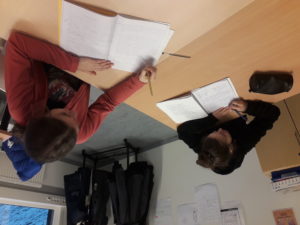
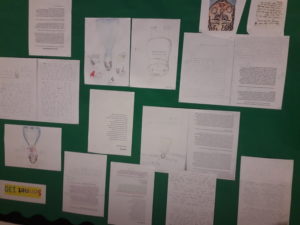
Students in Grade 8 have been exploring poetry from around the world in English Language and Literature class. They have been reading poets from different nations, backgrounds and time periods – even poets writing in different languages. Students have slowly developed their own analytical tools over the course of the half-term. Through analysing and discussing these poems from around the world the students have been invited to consider how much – or how little – the topic and concerns of these poems change, and how these are relevant to their own lives and forming their own identities
Students have also forayed into writing some of their own poetry, considering the skills and techniques needed to craft a poem that is effective in conveying shades of meaning, and produced some excellent efforts.
Barnaby Davis
MYP Language and Literature Teacher
Grade 9 students argue the perspectives of a case study.
2 December 2020
When students participate in structured oral communication before writing, this develops their understanding of the issues before they plan their formal assessment.
On Tuesday and Wednesday Grade 9 students debated solutions for the Congo River Basin. The six teams represented Environmentalists, Mining Companies, the United Nations, Loggers, DR Congo and Indigenous groups. Each team prepared opening statements, contributed two points of rebuttal or affirmation of other teams, and a closing statement.
Many students performed their roles in character, and demonstrated their ability to think on their feet. It was sometimes difficult for teams to identify with the perspective they had been given to defend, a pertinent reminder of the IB Mission Statement, which encourages students to become … ‘lifelong learners who understand that other people, with their differences, can also be right’. The students spoke passionately and fluently, demonstrating their ability to listen to others’ points of view, while defending their own.
The attached photographs show the class in action, with their MYP Individuals and Societies teacher, Mr Timothy Mills.
Are we in deep water?
30 November 2020
Grade 3 has been exploring how our planet has limited resources that are unevenly distributed. They looked at the difference between finite and infinite resources with a focus on water and how it is unevenly distributed across earth. Over the course of the unit, the students have seen how little clean drinking water there actually is on earth. This prompted them to analyse water-wasting and water-saving habits, and how it is everyone’s responsibility to conserve water. They also explored how much of an impact plastic pollution has on our oceans and its sealife.
Grade 3 took part in a collaborative process to share and agree on different methods through which to demonstrate and share their learning with their classmates. The options the students settled on were: a PowerPoint presentation, an information video, a presentation of an information poster or an educational comic strip. Having the opportunity to generate and select what form of summative task they would focus on really instilled a lot of enthusiasm and engagement in the students. They were given a deadline, a planner and a list of resources connected to the unit, so this process really tested their independent research and self-management skills too.
Presentations, posters and videos were shared this week and the audience members were tasked with providing feedback to the presenters. The class did a fantastic job of supporting their classmates, providing positive and constructive feedback whilst showing a lot of genuine interest and appreciation.
Matthew Peacock
Grade 3 Homeroom Teacher
Learning About Change
7 October 2020
Grade 2 have been working on a unit in How We Organize Ourselves and one of the concepts we have been learning about is change. In order to do this on a regular basis, we added a few apples and a couple of potatoes to a display at the top of a cupboard in the class. Students were invited to make regular observations of these items, to watch for changes that are happening to the apples and potatoes.
Before starting our UoI lessons we would take these items from their display area, pass them around, and look closely for changes we could note on our chart. A few students thought it would be interesting to poke holes in one of the apples, so we discussed how that changed the whole experiment because the holes changed the outcome to that particular apple. It was a shame that someone felt the need to do this, but we did learn something from that action as well.
For homework we also focused on the changes that are going on around us in the environment as Fall settles in and prepares us for winter. Change is quite a simple concept for children to understand, and visiting any concept through various perspectives can deepen our understanding of that concept.
Heidi Brenner
PYP Coordinator
IB Journeys in Gjovik
18 September 2020
Gjøvikregionen International School offers two IB continuum programs that form part of the smorgasbord of educational offerings for Innlandet residents. The Primary Years Programme (PYP) and Middle Years Programme (MYP) prepare students for the Diploma Programme (DP) at Gjøvik High School. The DP is academically very rigorous, and this explains some of the features of the two programmes offered here. A benefit is that successful completion of the DP acts a ‘global educational passport’ that prepares students for universities worldwide, opening a greater range of potential careers than may be available locally or even nationally.
The foundation years in any school represent a very significant part of child’s life (see diagram), which decreases with age. At GIS, the PYP prepares children by teaching through inquiry, often involving their own agency.
The MYP bridges the PYP and the DP and has features of both. The impact of school on students’ lives may be less intense. They still have independence as inquirers but there is a new requirement to use prescribed, world-wide standards (rubrics) for assessment. These standards are global. MYP teachers are also disciplinary specialists, in other words, they have university qualifications in the subjects they teach. The complex, fixed timetable also means that MYP students are more reliant on their own self-management skills.
Students new to the MYP adapt to these demands quite quickly, but as with any life skill, the learning is a result of engagement, of doing.
Students new to the MYP adapt to these demands quite quickly, but as with any life skill, the learning is a result of engagement, of doing.
Take a look at how teaching and learning develop in just one MYP Subject, Science, at GIS. Five weeks into the academic year:
• Grade 7 students have been strongly guided to develop practical and thinking skills for independent science investigations. We are impressed with their collaborative skills and how they work responsibly.
• Grade 8 students are completing independent investigations into force fields (static electricity or magnetism). In each year of the MYP, each student needs to complete one science investigation independently.
• By Grade 10, science subjects are becoming more closely embedded with mathematical skills, such as algebra. These two students have designed their own investigation into stopping distances, to be analysed using Newton’s Laws of motion.
Schools are about developing life skills. In our separate IB programmes or in our subjects we only have your children for a few years of their learning journey. We trust the experiences they encounter and master will help them develop confidence to meet the challenges of their future lives with success.
Annie Termaat
Secondary Principal
Healthy Habits
8 September 2020
PYP1 has got off to a roaring start. There is really no stopping us. Students are already in the finding out phase in our current unit of inquiry, ‘Healthy Habits’.
The class have been learning about routines and why they might be good for us. Some ideas from the children were – “routines are good, they help you to get ready.” “If we didn’t brush our teeth every day, our teeth would fall out and we couldn’t eat.” “Routines, help to know what is happening in the day.” As you can see, we have had some wonderful discussions in PYP1.
The children are learning to be real risk takers and are beginning to have a go at sharing their ideas. This week, the children participated in a gallery walk and looked at several pictures of different foods, children playing sport, children sleeping, children playing and more. PYP1 decided whether the pictures would make their bodies feel happy and healthy or sad and unhealthy. They did this by quietly walking around listening to relaxing music and putting post it notes of happy or sad faces next to the pictures to express how they felt about the pictures. We found out that we all agreed it was important to eat healthy, to play, to go to school and sleep so that our bodies stayed healthy and we wouldn’t get sick.
As a class, we also unpacked the foods eaten by the ‘Hungry Caterpillar’ and discussed which ones were healthy and which were unhealthy using a venn diagram. During the lesson we also talked about which foods would be ok to eat ‘sometimes’. It was agreed upon by all, that it is ok to eat ice – cream sometimes.
Alongside, our unit of inquiry, students in year 1 have been busy learning numbers to 10 and letter names and sounds. As you can see, we are definitely becoming a vibrant, knowledgeable and curious group of leaners!
Welcome back!
23 August 2020
The first week of a new academic year is always a busy but exciting time. As usual, we were particularly thrilled to meet Grade 1 students. The children seem to have settled in quickly and are ready for the many adventures that await them at GIS. And what an exciting time it is for their parents! Enjoy watching your child growing academically and socially.
We start this year with 177 students, many of whom have at least one older sibling at GIS. We are very proud of the fact that GIS families consistently choose us for their younger children as they start school. It’s a sign of your trust in us as well as your satisfaction with the quality of education that we provide.
The school has also expanded physically as we acquired additional rooms in the neighbouring building. A big thank you goes to the Learning Centre for sharing their space with us! We have a new, bigger library, a dedicated art room and a bigger music room now as well as an area for the learning support department. Unfortunately, due to the current infection control measures, we can use the new rooms only to a limited extent. However, they already enhance the teaching and learning at GIS and we hope to use them fully soon.
I would like to take this opportunity to thank all colleagues for their hard work to prepare GIS for the start of this academic year and wish all students parents and colleagues a great year!
Adam Armanski, Head of school
Grade 10 Chemistry in 2020
2 February 2020
Grade 10 have been learning about molarity in science, the way amounts and concentrations of substances are measured.
As a practical test of their knowledge, they were asked to use titration with a known concentration of sodium hydroxide to determine the molarity (concentration) of ethanoic acid in three vinegar samples.
This was a fantastic way to demonstrate the culmination of four years of chemistry! As you can see from the images, they worked thoughtfully and collaboratively, and were able to determine reliable results.
Why the World Was Never the Same Again
26 September 2019
In Grade 9, MYP Science revisited familiar science topics from a new perspective: how scientific revolutions cause a ‘paradigm shift’ in the way we think. A well-known example of a such a revolution is how we now understand the Earth is ‘just’ another planet revolving around the Sun. Scientifically, it can never again be seen as the ‘center of the universe’.
One of the students’ summative tasks was to present an example of a scientific theory that had changed as a result of new scientific evidence, as a museum piece. They had about 5 lessons in which to complete this work. The students were clearly interested in their selected theories and spoke with enthusiasm and conviction. Their imaginative and interesting exhibits are currently on display in the school foyer.
Ms. Annie Termaat, Secondary Principal and MYP science teacher
MYP Service as Action
6 June 2019
All MYP students are required to plan, carry out and reflect on service activities in each year of the programme. This academic year, many of our students have been particularly active. In addition to volunteering and helping out during special activities, such as Book Week and Constitution Day, a number have completed special projects that have improved the school.
- The homeroom is the classroom in which each grade completes lessons in most of their non-elective, non-specialist subjects. To help make the Grade 7 homeroom a welcoming, cosy place, like a home for all students in her class, Hedda, Grade 7 designed and made an attractive frame for the clock, an effort which required 10-12 Personal Inquiry Time sessions.
- Many students at GIS would appreciate a warm lunch, particularly during the winter months. Over a period of 8 months, Emil and Elias, also in Grade 7, raised the funds for a new microwave with bake sales. Their approach involving orders before the second bake sale was particularly impressive, because this meant there was no wastage. The ‘student microwave’, and ‘instructions for use’ are located in the kitchen and are available for use by all GIS students.
All these MYP students, and others, are demonstrating how they serve the IB Mission ‘to create a better and more peaceful world through intercultural understanding and respect.’
Ms. Annie Termaat, Secondary Principal and MYP science teacher
Community & Service in the MYP
29 March 2019
All GIS students complete community and service during Personal Inquiry Time. However, when appropriate, service aspects are also included within subjects.
In science, Grade 6 have just completed personal investigations into materials that prevent heat movement. Then they used their findings to design medicine carriers which would help developing countries without refrigeration transport medicine.
Some of their carriers will be on display on the table outside the front office this week!
Ms. Annie Termaat, Secondary Principal and MYP science teacher
Houses and Homes
22 February 2019
Grade One has enjoyed their first few weeks, learning about houses and homes. To launch the unit, students had the opportunity to share their own house with their friends, as they played a guessing game. They tried to match the exterior of the houses with the correct bedroom. From that activity, students concluded that it is impossible to know which room belongs to which house without prior knowledge. They touched on the idea of what makes a home a home, an area we will explore more later during the unit. However, students mentioned their family, toys, pictures and pets make their houses homes!
Ms Sabina Michelotti, Grade 1 teacher
Grade 3 visits Nammo
7 February 2019
Ms Kimberley Zemlak, PYP Coordinator and Grade 5 teacher
Christmas around the world
8 December 2018
Grade 1 has slowly but surely made a start into their unit: Transdisciplinary Theme: How we express ourselves
Central Idea: We celebrate special events throughout the world in different ways.
Lines of Inquiry:
1) Unique characteristics of traditions and special events.
2) Why people celebrate
3) Similarities and differences of local and global celebrations locally and globally.
Ms Sabina Michelotti, Grade 1 teacher
Thinking routines
30 November 2018
In our unit of inquiry, students were introduced to the visual thinking routine I see, I Think, I Wonder, to help students observe and develop ideas. We practiced with some images from Mexico’s Day of the Dead festival and then looked into the burning of the rainforests and the subsequent destruction of the orangutang habitat in Indonesia in order to grow palm oil.
Of course, the students were most excited this week about our addition of a large bin of Lego in the classroom. The students look forward to playing with the Lego at the end of the day.
Eric Zarouba, Grade 2 teacher
Grade One Took Action!
What a wonderful way to finish the week! Grade One had a blast selling their mouthwatering baked goods that brought many smiles on a busy Friday. Students managed to raise 1,700NOK! Which Mr Armanski stated is the current bake sale record at GIS!
Not only did students demonstrate maturity and integrity during the bake sale on Friday but also in their choice of where the money should go.
Students voted on the cause, deciding that they can do without a pizza party. They will be sending the money to help Zoja, a little girl born with webbed hands and feet who needs a lot of medical care. She is from Poland and the treatment available for her is in the States, so we are hoping that with Grade One´s support we can make a small difference to this little girl’s life. If you are interested about the cause click on the link.
Grade One might have the chance to talk to Zoja’s parents in the coming weeks.
Thank you to all of you for your time and effort!
Grade 7 Buddies
Earlier this week we had the chance to visit Grade 7 and share the TIME CAPSULES they created. They shared with us information and artefacts from ancient civilisations. The class was very excited to see ancient writings and forms of communication. They asked great questions. Working with a partner,we are creating our own alphabet code systems today in art!
Ms Kimberley Zemlak, PYP Coordinator and Grade 5 teacher
Classroom Economy
12 October 2018
This week, Grade 5 Awesome students were introduced to our classroom economy. This classroom economy will serve as a model on which we can base our discussions comparing and contrasting barter, trade, and commerce – with a hint of fiscal responsibility.
How it works:
Students will be assigned classroom jobs on a weekly basis. At the end of each week, they will be paid in “Toohey Tokens”. They can, then, use those tokens to buy items from the classroom store.
I have stocked the store with items that I purchased while visiting the United States; however, these items will soon be depleted and donated items are always welcome and students will receive bonus cash when they donate items to the store.
Mr Eric Toohey, Grade 5 Awesome teacher
A Week in Grade 4
18 September 2018
Last week was an exciting week for us! We had a visitor on Monday who taught us how to blow the shofar and we ate apples with honey and challah bread for Jewish New Year. On Wednesday, we celebrated International Chocolate Day and drank hot chocolate. Student Council managed to raise 1500kr! On Friday, Ellen Johansen came to talk to us about people with disabilities and how people’s beliefs about people in wheelchairs affects the way they react to them.
Ms Cindy van den Heuvel, Primary Principal and Grade 4 teacher
Numbers, letters and food groups!
Grade One, enjoyed consolidating their number skills, spending time on counting forwards and backwards whilst enjoying playing hopscotch! They tested their multitasking skills as they counted, jumped and balanced down the hopscotch course.
Interdisciplinary units: a special feature of the IB Middle Years Programme.
All IB programmes seek to help students know, understand and use meaningful connections between subjects. While learning in the PYP is organised using shared transdisciplinary themes of inquiry, in the MYP subjects are taught by many specialised teachers. Therefore, instead, students in every year group must participate in at least one interdisciplinary unit (IDU) every year. The idea is that when disciplines (subjects) interact, special, new understandings will emerge.
All of our MYP students have now participated in one of these IDUs. Can you guess which subjects were involved, based on their ‘statements of inquiry’?
Grade 6
Global connections. Individuals are connected to the world in a variety of ways. Interactions between people and place show we are living in a globalised society.
Grade 7
The expression of our personality and cultures is amplified when musical instruments are crafted to create sound based on scientific relationships.
Grade 8
Statistics and graphical representations can be used to analyse and make explicit (clarify) how communities experience social change.
Many students seem to have enjoyed their experience. As teachers, who have all been developing our curricula this year, we have also been learning how our subjects can work together in original and meaningful ways. We will grow from this by using what worked well, and changing a few things in the future.
IDUs are assessed using a special, separate written task in which students reflect about their learning experience. Over time, and with practice, this exercise is intended to help students know their own strengths are learners, and develop understanding about how they can transfer their learning in all kinds of different subjects to new situations.
And that self-knowledge is very empowering!
Ms. Annie Termaat, MYP Coordinator and science teacher
Polished, Passionate and Proud
15th April
Those are the three words that come to mind when reflecting on this year’s Student-Led Conferences. All our students were outstanding examples of what the PYP is all about. They presented their Portfolios to their parents with confidence, showing that they are developing into outstanding communicators. They were proud of their progress throughout the year as evidenced in the way they shared their portfolios with their parents. Our students were enthusiastic about showing how passionate they were about their learning.
Watching students demonstrate how to blend colours, solve a Maths problem, read a book with expression, dribble a ball with a hockey stick, play a musical instrument, was a proud moment for teachers as we could see how students transferred their learning and put it into practice.
Student-Led Conferences are an important assessment in a PYP School. Students are involved in choosing their portfolio samples and reflect on their choices. They meet with their parents and they are in control. This makes students take responsibility for their learning, and they were responsible, taking great pains to educate their parents about how they learn in a PYP school.
These weren’t just Student-Led Conferences. They were Student-Led Celebrations!
Cindy van den Heuvel, Grade 3-4 teacher
What Is a Student-Led Conference?
10th April 2018
Next Thursday, April 19 is PYP Student- Led Conference day at GIS!
For anyone new to this, please note that the format is different from a parent- teacher conference. Essentially, it is a scheduled opportunity for you as parents to sit with your child and share a collection of work samples they have gathered in their individual portfolio. This is their moment to share select pieces and experiences that illustrate their personal strengths, areas for improvement and/or things that make them especially proud.
As a result of the conference, it is our hope that families will celebrate learning milestones and also take time to create goals and strategies for supporting student growth and improvement.
Each child will lead their own 45 minute session, and teachers will be nearby to facilitate if needed. Parent discussion questions will also be available as suggestions, to help stimulate rich dialogue. Currently, all Grade 1-5 students are preparing and practicing for conferences.
For more SLC information please see: http://www.edudemic.com/guide-to-student-led-conferences/
We look forward to seeing you next week!
Kimberley Zemlak, PYP Coordinator
March is Reading Month
16th March 2018
We decided to celebrate Dr. Seuss’s birthday by inviting students to complete a number of reading-related challenges throughout March. We have started with a “Reading Challenge” where the kids were supposed to complete a Bingo-like sheet with silly Seuss-inspired reading activities like Read out loud, Read upside down, Read under a table, Read to someone small, etc. When a child had 5 in a row in any direction, they could bring their sheet back to the library and receive a free bookmark. When they completed all of the activities, their picture was added to the Read Wall of Fame outside our GIS Library. We had a lot of motivated students coming back the following day with a finished sheet. They all said they had had a great time reading in different places or doing different activities.
Another activity this month is the “Bookmark Challenge”. Students were asked to design a bookmark with a book theme, quote or their favourite book characters. Winners will have their bookmark printed for everyone to take home. Although the challenge started only yesterday, we already have some children submitting their ideas.
Eva Griesova, GIS Librarian, EAL Support
From the R to the H to the Y to the THM, THM, THM
5th March 2018
All is number, Pythagoras said. Sound is waves, Vitruvius said. Name is rhythm, Grade 2 concluded after we wrote all our names on the whiteboard. What was meant to be an activity of comparing and grouping different rhythmical patterns from our names turned out to become a rich display of the name variations present in Grade 2.
By repeating a name several times in the time signature 2/4 (counting one-and-two-and one-and-two-and) the task was to decide how a name ought to be written according to its significant rhythm. Quite early, it became obvious that this particular class holds many unique name rhythms.
Some of the names could even fit into several categories, depending on the individual choice of using one or both names, or alternating the use of them. Carl has an emphasis on Carl: Carl-and-two-and-Carl-and-two and so on. Carl Fredrik has an emphasis on Fredrik, making Carl the anacrusis in this rhythmic pattern: Carl Fredrik-two-Carl Fredrik-two and so forth.
The lesson called for applying techniques such as subdivisions of metric patterns, anacrusis and not at least determining the duration of each syllable according to the time signature. Labelling each variant A, B, C, et cetera, Grade 2 ended up with 15 different rhythms from 23 individuals, assistant and teacher included. We had our laugh of the week as more and more patterns occurred.
Geir F. Stavsøien, PYP & MYP Music teacher
Grade 5 in Lillehammer
22nd February 2018
On Tuesday February 20, the Grade 5 class enjoyed a very successful and timely outing to Lillehammer, in support of our current unit of inquiry about “event planning and the current Winter Olympics” to visit the Lysgårdbakken Ski Jumping Arena at the Olympiaparken and the Norwegian Olympic Museum.
The day began as the whole class walked the outdoor venue to see the 1994 Olympic Flame and and then walked up 500 stairs to the hallway point of the ski jump. We got first hand views of training athletes and coaches in action. We were able to see over 2 dozen training runs and also interview one of the jumpers about his goals and program.
The afternoon was spent at the Olympic Museum. We were graciously greeted, had our own room and space for lunch. We visited all of the exhibits, watched movie footage of historical events, opening ceremonies and even live coverage of the current Pyeongchang Games.
Students say that their favourite highlights include: artefacts like the torches, old wooden skis, medals and clothing; the 3D glasses of a simulating a downhill ski run, the interactive biathlon race track and shooting range, taking photos and taking photos, and, well, the gift shop!
Ms. Kimberley Zemlak, PYP Coordinator and Grade 5 teacher
Sami Day at GIS – Tuesday, 6th February 2018
On Tuesday we celebrated Sami Day here at GIS. Grade 5 were given the mammoth task of cooking a traditional Sami reindeer stew with mashed potatoes for the whole school to taste. They took on the challenge with impressive positivity, energy and enthusiasm, displaying great communicative and collaborative skills. Needless to say the stew tasted delicious and both pupils and staff enjoyed a great lunchtime feast!
During their Norwegian lessons the students also learned about Sami culture and traditions both on PYP and MYP level. Some of the activities on the day involved creating wall displays, watching a video about Sami lifestyle, learning about Sami people, pronouncing and writing some common phrases and learning about fairy tales and the traditional way of singing, “joik”.
Nina Haavi, PYP Norwegian teacher
Bezier Curves and Boolean Operations
26th January 2018
Both MYP students and I were eager to put our hands on the new MacBooks, which arrived as an early Christmas present. With this upgrade to our IT system, new doors have opened before us in digital design. Behind these new doors lie new challenges: Nodes and shapes take the scene in the MYP.
Grade 6 and 7 students are learning about vector graphics. While our focus is on identity and branding with Logo Design in Grade 6, we are working on marketing and communication in Grade 7 through our Book Cover Design unit. Grade 6 students will develop a complete understanding of the logo design process. And in Grade 7, the saying “Don’t judge a book by its cover” will get a whole new meaning.
Grade 8 hit the books. The students will research a successful digital product and explain how it changed the way we live our lives as well as what made the product successful. They will acquire a strong understanding of the need to consider the target audience and how that need can be met successfully as well as why everything is becoming “smart”. All this “groundwork” will become very important in our next unit, where the students will design and create their very own digital story book adventure.
I am already excited to see all the logos and book covers.
Ragnar Görögh, MYP Design teacher
Creativity in the PE classroom
8th December 2017
From Golf to Kabaddi, students in the MYP PE classes have been learning about some unique and creative sports. Earlier this year, MYP 2 and 3 students were challenged with creating their own golf course based on the area around the NTNU campus. Students learned about the rules and regulations for playing a real game of golf and then applied it to a new and creative way of playing. We had everything from Frisbee golf, to mini-golf and even more creative arrangements such as boot throwing or hockey golf.
In the MYP 1 class, students have started their warm-up projects where they take a sport of their choice and create a warm-up specific for that sport. Students are encouraged to research professional sport teams and model some warm-up drills as well as target specific muscles that will be used for the sport. Last week we learned about the Tamil Talaivas and the Bengal Tigers, teams that were a part of the national Kabaddi league in India. Students then participated in drills that are also used by teams in India for their training purposes. In the past, we have had students demonstrate warm-ups for sports ranging from football and handball to ballet and horse-riding. This year’s group looks to be just as exciting.
Timothy Mills, MYP Teacher
Writing Workshop MYP 3
17th November 2017
How do you write a good text? How do you make sure your text answers all the questions it should answer?
These questions are an important part of the current unit in Grade 8. All students have chosen a topic under the big umbrella Globalization. After that, they came up with a set of guiding questions, to guide their work along. Some students have changed their questions over the course of the unit as a result of their research, which gave them a new direction for their writing.
After they finished their guiding questions, they did research and planned their assignments. Over the last weeks, we turned our regular Norwegian lessons into writing workshops, where students write parts of their assignments, and receives feedback when they request it.
This unit has taught the students different structuring techniques, academic writing skills and time management skills. They have also been reminded of the importance of academic honesty and practised using MLA citation style to structure their sources and in text citations.
Mr. Espen Øye Bjørkvold, MYP Norwegian teacher
Doctors and Nurses
From learning about farmers and spending a fun-filled day at the farm, Grade One moved on to inquiring about doctors and nurses and their role in the community.
Grade One made some good connections:
- Nurses can help doctors.
- Doctors need stethoscopes.
- Nurses and doctors help people.
- Nurses help us.
- Doctors help people who are sick.
- The doctor helped my brother when he broke his leg.
- A doctor helps me to be healthy. He has a mask.
Ms. Sabina Michelotti, Grade 1 teacher
Transdisciplinary Learning in Grade 5
22nd September 2017
 |
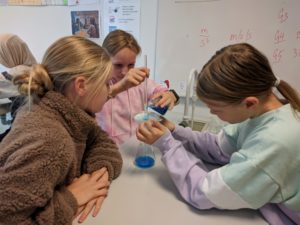 |
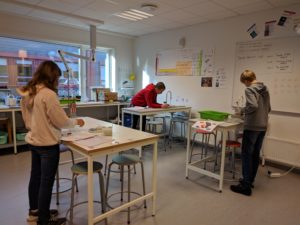 |
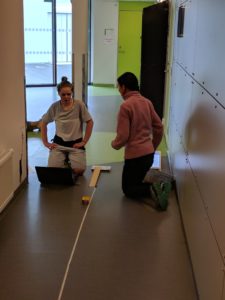 |
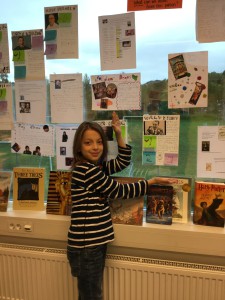 |
 |
|---|---|
 |
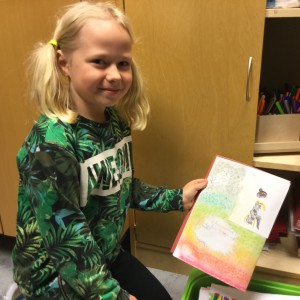 |
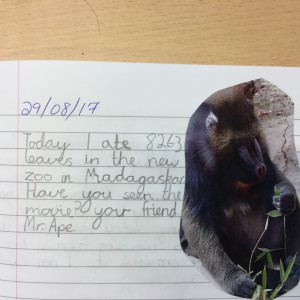 |
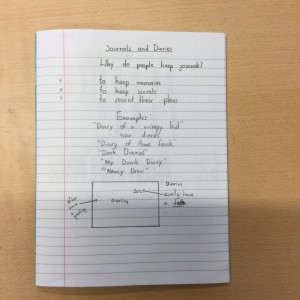 |
The following photos reflect some of the progression of our first unit of inquiry, which falls under the transdisciplinary theme of How we express ourselves. Guided by the central idea “Throughout time people have used various methods of recording thoughts and ideas and sharing their personal stories” we have been exploring examples of journals and diaries in history and literature, and made many connections to famous biographies and autobiographies. Fifth graders have been busy reading articles, researching individuals of personal interest and writing journals from different perspectives.
Because this first unit has significant language content, we recognize that not all students in our class would be able to articulate their creative thinking and understanding in written form alone. Teachers and assistants help some students articulate their verbal responses, with translation or scribing required in some cases. One great thing about transdisciplinary learning, such as that structured by PYP units of inquiry, is the conversations and broader connections that are made with single subject specialists in planning meetings.
While there is no pressure to ensure that PE, Art, Music and Norwegian teachers “fit in with what happens in class” there is freedom to test out different approaches. When links across the curriculum appear as significant and highly relevant for the learning, exciting things happen. Various disciplines inform one unit of study, to provide multiple pathways for students to explore ideas and express their understandings.
In this first unit, such connections were made between homeroom and art and design technology classes. To extend the thinking about journals and diaries, the students explored different examples of scrap books in visual art class. They used different techniques and media to communicate and reflect on aspects of their week and quickly became very proud of their artwork. In Design Technology, they used information from their personal biography research to develop and apply new PowerPoint skills, such as importing images and creating transitions between slides. “Can we do this every week?” a few students asked!
Our single-subject teachers play a vital role in this type of learning and will connect with many units of inquiry across grades 1-5 this year. They expand the thinking and provide rich, engaging, multidimensional experiences for all our learners. We are really lucky at GIS to have such a dedicated and talented team in these domains!
Kimberley Zemlak, PYP coordinator and teacher.
A laboratory makes all the difference!
8th September 2017
GIS’s new building includes a specialist science laboratory! Having access to water and bench space mean we can already include simple experiments and demonstrations in our lessons. All MYP classes are contributing to its facilities.
MYP 1 have developed a comprehensive set of safety rules as part of their introductory unit, What is Science? It will not be long before they will be testing devices which protect eggs.
MYP 2’s inquiry Who are we? Reflects on the role of DNA, which they modelled in cardboard and extracted from strawberries.
MYP 3 have started with chemistry, How do we map matter? They will enhance the space with alternative representations of the Periodic Table.
Stand by for more exciting times ahead!
Annie Termaat, MYP coordinator and science teacher.
Welcome back!
27th August 2017
The first week of school was very exciting for students, parents and school staff alike. We welcomed over 40 new students, which means we’ve grown by over 60% in comparison with last year. We also welcomed 7 new staff members and are awaiting the arrival of another 2 in the next few weeks. Each new member of the school community brings his/her experience from previous school(s), his/her mindset and expectations. Each new student and staff member is a new world. We look forward to seeing how this new input enriches us as a school and a community. We believe the interactions between returning and new people will be inspiring for everyone and will make GIS an even more stimulating environment to teach and learn in. Good luck, everyone!
Mr. Adam Armanski, Principal
Spirit Week in Grade 1
7th May 2017
Last week all the children from GIS participated in Spirit Week, in which they could express their creativity. Each day was dedicated to a different activity e.g Math, Film, Books, Toys and Surprise.
The students from Grade 1 were responsible for organising Teddy Bear Hunt and Teddy Bear Picnic for lower classes at GIS. All children from Grades 1-3 were asked to bring their favourite toy which they could play with during the day.
We were also all dressed in the colours of GIS logo i.e red, black and white. Everyone proved to be very creative, one child even made her own T-shirt with a slogan ‘I LOVE MY SCHOOL’ with the use of appropriate colours.
Ms. Eva Griesova, Grade 1 teacher
Great Things
21st April 2017
Vincent Van Gogh once said that “great things are done by a series of small things brought together.” This statement is certainly true about numerous things which happen at GIS, including art projects. Just recently, Grade 6&7 students spent several weeks working on unique projects inspired by Sonia Delaunay´s abstract art designs. Just like other ´great things´, these big format collages were created from ´small things´ – pieces made using a variety of media and techniques. The final result stands out as a prime example of our students´ talent, enthusiasm and creativity. The works have been framed and will soon be displayed in the new school cafeteria to please the eyes of GIS community members and visitors.
Agata Wieczorek, Art teacher
IBPYP Students: Active Agents of Their Own Learning?
As dark of winter disappears and we bask in the spring sunshine, it is also time for our students to bask in the beaming faces of their loved ones as they share their triumphs, challenges and joys of their personal learning journeys. Student-led conferences are an opportunity for students to enjoy time with the families sharing what they have experienced throughout the school year thus far. Students take the lead in planning, preparing, sharing and reflecting during these conferences. It is a unique opportunity for parents to see and understand how their child views his/her own learning.
As student-led conferences are planned and prepared by the children with teacher facilitation in each class, they work collaboratively to decide what they view as the most important aspects of their learning during the year and how to share this with their families. It is also a powerful opportunity for parents and teachers to see children as active agents of their own learning, rather than passive participants in teacher-driven activities. With students designing and driving the conference, it also gives parents an opportunity to experience the progression of their child’s learning as they progress through the grade levels, witnessing the increasingly complex conceptual understandings students are able to articulate, explain, express in their own way while making connections within their world.
At GIS, learning journeys are documented through the use of portfolios. Students chose, expand and reflect on their learning by choosing pieces which exemplify their learning in a variety of learning areas, demonstrating a variety of approaches to learning and learner profile dispositions. Students are able to do with increasing independence as they mature.
When interacting with your child during student-led conferences, there are several ways to support your child in the sharing process.
Arrive on time and be prepared to stay for the full 45 minutes. The children have put a great deal of effort into preparing the experiences for you and will require the entire time to go through the experience they have planned for you.
- Talk to your child as they guide you through the experiences. “Tell me more about why you chose to put this in your portfolio.” “Why do you think this is important?” “If you could change one thing about this piece, what would it be? Why?” Do not hesitate to ask clarifying questions or seek out more information.
Ensure your child has your full attention. This is not a parent-teacher conference. The teacher’s primary role during the student-led conference is to act as facilitator for the child in the explanation of their learning. If you would like to discuss your child’s progress with their teacher, please make an appointment to do this at a separate time.
- Ensure your other children are in SFO so you are able to completely focus on your child and their learning journey.
We are actively planning our student-led conferences and look forward to seeing you all there, enjoying this time to bask in the faces of our children as they share their triumphs, challenges and joys of their learning journey.
For more information on student-led conferences in general, please see the links included below.
Trish Phyall, IBPYP Coordinator and Gr. 4/5 Teacher
For more information on student-led conferences and three-way conferencing: http://assessment.tki.org.nz/Reporting-to-parents-whanau/Examples-and-templates/Student-self-assessment-and-reflection/Student-led-conferences-and-three-way-conferences
For more information on student-led conferences within the IBPYP context: http://blogs.ibo.org/sharingpyp/2013/06/04/student-led-conferences-putting-the-students-learning-first/
Polygons are everywhere!
17th March 2017
Whether it is in Ms. W’s Art lessons, out on the playground, or a Math class, polygons seem to be taking over the school these days. MYP students have been learning about these, building blocks of geometry and wondering where we can find them in the world. We’ve studied how polygons are vital to abstract art and witnessed the importance of shapes in design and architecture. Students even took time to identify and photograph polygons from their winter break, giving us examples from all over the world including China, the Caribbean, London, Paris and the Canary Islands.
During class, students have been categorizing polygons and learning how to draw cubes, pyramids and prisms. Transferable skills from art class, such as using perspective, have been helpful and reinforce learning. Exploring the world through the eyes of a middle schooler is always an adventure and it has been fun seeing where they find polygons.
Timothy Mills, MYP Teacher
Follow us down the road
10th February 2017
The second and third grade class were busy this week inquiring deeper into their unit on exploration. Our focus was on the possible reasons people explore. We learned about different types of explorers, had a guest visitor and learned about who Columbus was, where he went and what he found when he got there. Students showed and reflected on their knowledge by writing in their own travel journal.
Students are learning about reflecting on who an explorer was through the scope of four questions:
What was their background?
What were they looking for?
What tool/skills did they need?
What did they find and why was it special?
Paul Duevel, Grade 2-3 teacher
Words, words, words…
2nd February 2017
This week in Grade 1, we have been continuing to learn new sight words and have been playing fun games to accompany our study.
Successful readers use several tools to help them understand texts. One of the most effective and powerful reading tools that parents can help children develop is sight word recognition. When a child is able to grasp and identify sight words they are well on their way to becoming a thriving reader.
We have been preparing for St. Valentine’s Day in our room as well and Miss K has been coming in on Thursdays for our Crafting Thursday sessions. Miss K has been a superb volunteer in our classroom, who enjoys bringing her love of crafting into our classroom.
Gwynne Rasen, Grade 1 teacher
Looking for New Year’s Resolution Ideas? Look to the IB Learner Profile
12th January 2017
Happy New Year and Welcome to 2017!
It is that time of year again, when we leave the joys and woes of 2016 behind us and look forward to what 2017 will bring. Many of us will be making resolutions, losing our 5kg of holiday weight or spending quality time with family and friends. Why not look to the IB learner profile for inspiration?
The IB learner profile is a set of 10 attributes which drive international mindedness: inquirer, thinker, knowledgeable, communicator, caring, open-minded, courageous/risk-taker, balanced, principled and reflective. As IB learners, we are bound to this set of principles in our quest to be internationally minded individuals.
The beginning of the new year is an excellent opportunity to set goals with our families. Focusing on the learner profile attributes our families see as areas of development, setting goals together can encourage all members of the family to further develop their international mindedness. An example would be a focus on the learner profile attribute of communicator. Possible goals could include a focus on listening for understanding rather than listening to respond. Or encouraging children, as well as adults, to record their favourite experience each day, keeping these in a safe place, to be read aloud at the year’s end with the family to reflect on the joys of the year.
As the world becomes increasingly connected, the new year is a wonderful time to take a step back and refocus our efforts, assisting our children to develop their personal attributes. The IB learner profile gives us a framework for this development, as well as our own, to become more internationally minded individuals.
Trish Phyall, PYP Coordinator and Gr. 4/5 Teacher
The Power of the Excursion
2nd December 2016
As PYP Coordinator, I am often asked to explain to new parents at GIS differences between our classrooms and traditional classrooms, things which set our classrooms at GIS apart from others in the region. There are many answers to this question: the constructivist, inquiry-based classroom experience, the emphasis on the development of the whole child, the focus on critical thinking skills, the importance of real world experiences, and sharing of knowledge and understanding through collaboration and cooperation. These components of the IBPYP experience at GIS are all accessible for students, but we offer more than the stereotypical “at school, in the classroom” learning experience. Students also participate in excursions (or field trips) within the local community, and further a field as they mature, which are designed to deepen the students’ understanding of concepts being explored within their classrooms.
Excursions give students an opportunity to put the concepts and ideas discussed during classroom learning experiences into a real-world context. They can also be used as a discussion prompt, giving students a joint experience to begin the conversation and deepen their understanding.
Although constructivism, inquiry and the importance of experience are partially based on Jean Piaget’s work from more than 60 years ago, there is also more current research to support the importance of the excursion experience. Research from Jay Greene and his colleagues at The University of Arkansas released in 2013 demonstrates that understanding and learning can be greatly influenced after “a single, guided tour of an art museum”. Students demonstrated increased cultural interest, critical thinking, tolerance and empathy, all important components of the essential elements of the Primary Years Programme and what we do at GIS.
If you would like more information on the importance of excursions, please find some sample links below or contact me directly.
Trish Phyall, PYP Coordinator and Gr. 4/5 Teacher
For more information on the work of Jean Piaget: www.piaget.org
For more information on constructivist teaching methods: https://en.wikipedia.org/wiki/Constructivist_teaching_methods
For more information on the work of Jay Greene and his colleagues at The University of Arkansas: http://educationnext.org/the-educational-value-of-field-trips/
References
Greene, J. P., Kisida, B. & Bowen, D. H. (2014). The Educational Value of Field Trips.
Education Next, volume 14 (1).
Constructivist Teaching Methods. (n.d.). In Wikipedia. Retrieved October 30, 2016, from
https://en.wikipedia.org/wiki/Constructivist_teaching_methods.
It´s EIementary, my dear Watson!
18 November 2016
Inquiry as a form of learning goes hand in hand with the MYP science curriculum. This year our students have focused on learning about the scientific method, examining the work of scientists and what they do, and how to conduct experiments. To facilitate our learning we have visited the Vitensenter here in Gjøvik. The center gives us a chance to work in a laboratory and explore the tools used by scientists. Our most recent visit focused on forensic science. Students worked to solve a mystery about a stolen painting. Through research and questioning students were able to test their hypothesis, draw logical conclusions and determine the culprit. Science can be exciting and conducting science is in fact often like being a detective.
Timothy Mills, MYP Science teacher
To Buy or Not to Buy?
3 November 2016
Our second unit of inquiry in Grade 2-3 has been focused on Marketplace. Students have been inquiring into where products come from and how vendors choose a price for what they sell. They explored this subject by setting up market stands within the classroom. They were tasked to take on vendors and with a simple currency asked to price their wares, and try to sell them to their fellow students.
We also inquired into the concept of supply and demand. Finally, we visited a local Europris to look at how the store was supplied in order to meet the local demand.
Students looked for items that fit the following categories:
- Items that were sold in large packs.
- Items that were being sold in bulk.
- Items that store carried only a few of.
- Items that were special.
Paul Duevel, Grade 2-3 teacher
First Field Trip for Grade 1
On Tuesday, Grade 1 students were given the opportunity to view a medical triage ward. We visited Mr Svarthaug, who is a nursing lecturer that specialises in anaesthesiology. He gave us a tour of the teaching labs and showed us how to help someone with a broken thigh bone as well as view a skeleton to see what the bone looked like from another perspective. Students were then given the opportunity to learn more about injection and how medicine could make you better. All the students were thrilled to give the doll an injection. A huge thank you to Mr Svarthaug for helping us get a hands on perspective for our unit of inquiry.
Gwynne Rasen, Grade 1 teacher
Safety first!
26 September 2016
Last week was filled with fabulous learning opportunities. Grade 1 was thrilled to share their understanding of community helpers with the school. We used our study of fire fighters and combined it with the school’s annual fire drill. Grade 1 spent a week focused on the topic of Fire Safety both at home as well as at school. The students shared their home escape plans with the class on Monday and we practised climbing out the window for our classroom escape plan. We also performed our Hurry Hurry Drive the Firetruck song for our school assembly as well as shared our learning.
Gwynne Rasen, Grade 1 teacher
How to Increase Our School’s Profile?
13 September 2016
At the very heart of the IB education we offer at GIS, there is a set of ten essential characteristics called the IB Learner Profile. Everyone involved in international education sooner or later comes across these ten magic words: inquirer, thinker, communicator, knowledgeable, caring, principled, risk-taker, open-minded, reflective and balanced. There are two ways of looking at the Learner Profile. One way is to teach it. Since all international teachers are primarily language teachers, they usually try to make these words accessible to all by illustrating them, displaying them around the school, completing crossword puzzles and word-formation activities, and by using them as much as possible while talking about daily school matters. There is yet another, much more powerful, way of embracing the Learner Profile, which is to live it! Even if you say the word ‘caring’ several times a day, you are not going to make others feel your care, if you do not genuinely care. Even if your students know that the word ‘principled’ is derived from the noun ‘principle’ meaning a basic rule, this knowledge does not help them stick to the rules. No matter how many times you call yourself a risk-taker, if you do not do anything to get out of your own comfort zone, there is no risk-taking happening. There is no way to become open-minded if you believe there is only one way and it is your way! We need to make sure that these ten qualities become a part of our individual profiles.
Grade 6&7 students tried to help us all see possible actions behind these big words by sharing practical examples of living the Learner Profile. The students were certainly curious inquirers while interviewing GIS community, analytical thinkers while selecting the details to share in their assembly, and effective communicators while delivering their message to the audience.
If we try to live the Learner Profile at GIS, we will enhance the quality of life and education taking place at our school; we will increase our school’s profile!
Agata Wieczorek, MYP Coordinator
Power of Feedback
27 August 2016
Long story short: nothing has a bigger impact on learning than constructive feedback. Not even beloved homework, which sometimes is an indicator for parents of how ‘good’ their child’s teacher is. Quality feedback can enable and empower. I learned about the power of feedback again when I taught a Grade 4-5 class yesterday. In small groups, the students were supposed to present what they had learned about the human brain before. Four groups chose to create a YouTube-style video. Extremely excited about the project, they wanted to record their clip as soon as possible, cutting corners. Each group presented and was recorded in front of the class. The audience gave all presenters feedback on what would have made the video more YouTube-like. This was supposed to be the end of the activity. However, three of the four groups asked if they could present again, incorporating the feedback they had just received. Unsurprisingly, their performance showed improvement and gave the students a lot of satisfaction. Good feedback enables.
The experience reminded me of the feedback I had received the previous academic year from a then Grade 1 student. It was a second time I taught a class to the groups of students. To the end, a girl asked me if she remembered correctly that I had taught them before. After I confirmed, she said, “Today was better.’ Feedback empowers!
We give and receive feedback every day, both at work and at home. How we give feedback and what we do with the feedback we receive can have a great impact. So, we have a fairly powerful tool in our hands as teachers, parents, colleagues, friends, siblings, etc. It’s entirely up to each of us how we use it.
Adam Armanski, Principal
Busy Time in Grade 1-2 Classroom
10th June 2016
The grade one and two classroom has been a hopping place the past few weeks. The children performed a fantastic production of The Three Little Pigs for their class assembly. We continued to add to the building of the classroom village; motor vehicles were added to the roads and more people were added for the park. The building of the village allowed the children to understand the need for city planning and the needs and wants of a community. In maths, we had blast learning about fractions and had a pizza party to celebrate our understanding. We introduced new fraction games as well as reviewed patterns and shape concepts through games.
Gwynne Rasen, Grade 1-2 teacher
Not All Those Who Wander Are Lost
(J.R.R. Tolkien)
Our sixth and final unit in Grade 3-4 has been focused on how human exploration has had an impact on society. As a homework assignment, students were asked to research and create a poster about a famous explorer.
When researching into their chosen explorer the assignment asked the students to find the answers to these questions:
- Who were they and where did they come from?
- When did they leave and what were they looking for?
- Where did they go and how did they get there?
- What did they find?
- What made this exploration special?
- How did their discovery change things?
On Tuesday during our school assembly Grade 3-4 presented their posters to the students from the other grade levels. It was a joy to see a room full of students eager to share their hard work and a group of students listening intently and asking great questions.
Paul Duevel, Grade 3-4 teacher
Busy Mornings at GIS
20th May 2016
The time between 8:15, when students are allowed in classrooms, and 8:30, when lessons start, should never be called ‘a lazy morning’ at GIS. Grade 1-2 have the opportunity to read and play. Grade 3-4 and Grade 5 students have their morning to-do lists, which keep them occupied with all sorts of engaging activities. The activities usually range from finishing little tasks from the previous day to buddy reading or solving language and maths puzzles with a partner, to sharing projects on display, to exchanging thoughts about the quote of the day or responding to learning provocations prepared by the teacher. Today, as usual, the narrow corridor on the first floor was buzzing with excitement. Intrigued by the photos on the posters from Grade 5’s Human Life Cycle display, some Grade 3-4 students stopped by and 5th Graders explained the purpose of the task to their curious younger friends. A few steps farther, several Grade 3-4 students were reading the Poem of the Week, a few were inquiring about the names which can be given to both flowers and people. Other students were in their classrooms, working on yet another item from their morning lists. Don’t we all love to start a day by ticking off a few boxes on our to-do lists?
Agata Wieczorek, PYP Coordinator and Grade 5 teacher
Around Norway in a Few Classes
29th April 2016
For the last couple of weeks Grade 3-4 students have been exploring Norway, trying to understand why tourists come to visit our country. One part of this task was to choose an attraction or an area of Norway and write a little text for a tourist brochure. After the choices were made and the drafts were written, the students were divided into three groups based on their topics.
Group East students are writing about the eastern part of Norway. Group West students are focusing on western Norway. Group North students are making their brochure about Northern areas.
It is great to see so many different ideas. And the students are putting a lot of effort into their work. We will finish the work next week.
Espen Øye Bjørkvold, Norwegian Teacher
Celebrating Learning
24 April 2016
This week has been very special for Grade 5 students at GIS, who have been celebrating their learning in the Exhibition. After seven weeks of extensive research about global problems of their choice, the students shared their findings and new understandings with the GIS community. During their presentations, they aimed to inspire others to become a part of the solutions to these problems. The audience of various ages could learn how to help the elderly, how to protect the environment to help preserve biodiversity, how to clean the oceans and how to help homeless animals. They also learned about the significance of microbiology, importance of veterinarians and complex relations between humans and animals. Most importantly, fifth-graders led all by own example, sharing the actions they had already taken themselves to make the world a better place. All of it because at GIS we believe that there is very little value to knowledge if it doesn’t translate into action!
Agata Wieczorek, Grade 5 teacher
The Final Countdown
14 April 2016
This week in 3rd and 4th grade, we have returned to a system of maths stations. The students have been put into three groups. Each group was asked to solve the complex maths problem of calculating how many days of school were left until the end of the year. Without a calendar this task proved to be a challenge requiring the students to use multiple types of maths operations to come to an answer. Once all groups presented the maths they used to work through their problem, they drafted four expectations that they would have of each other when working as a team. The students came up with a group name and each group member signed their group poster, acknowledging their responsibility to live up to their team’s expectations.
Next week, we will be moving on to learn about how to approach complex division problems.
Paul Duevel, Grade 3-4 teacher
Maths Is Fun!
1 April 2016
This week, grade 1 and 2 have been looking at the concept of patterns in our maths lessons. We learned about AB, ABC and ABCD patterns as well as variations. We have learned about patterns in real life (such as a bumblebee and zebra) as well as patterns around our school (lockers, doors and floors). We were very excited to get new math resources in our classroom this week to help us carry out our observations.
We used bears.
We used worms.
We used Lego.
We are looking forward to using our bears again next week when we look at the concept of mass.
Gwynne Rasen, Grade 1-2 teacher
PD @ GIS
18 March 2016
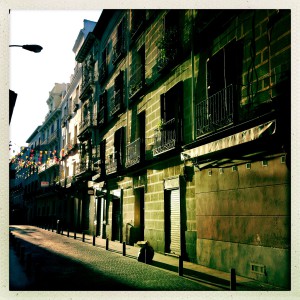
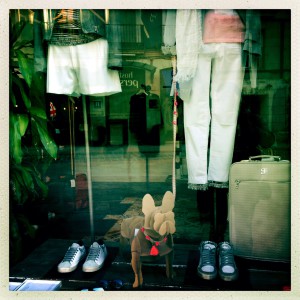
PD can stand for two things at GIS. It can be the initials of one of the staff members. It can also stand for Professional Development, one of the most significant aspects of our school philosophy.
As a community of lifelong learners, at GIS we promote a continuous growth among students as well as teachers. GIS teachers collaborate on unit planning and assessment, share their best practices and attend various workshops. Just recently, in preparation for my role of the MYP Coordinator next year, I attended an inspiring IB workshop in Madrid. I left Spain filled with reflections, ideas and strategies to implement at GIS. I also left the city of Madrid filled with plenty of aesthetically pleasing memories. As a Visual Art teacher, on my way to and from my IB workshop venue, I admired grand architecture, intricate decorations on old buildings in the maze of small streets, and unique shop window displays. Luckily for GIS’s budget, all the shops were still closed in the mornings and already closed in the evenings!
Agata Wieczorek, MYP Coordinator Designate
Our Very Own Jurassic Park
19th February 2016
For the past 5 weeks we have been looking at Life Cycles in our classroom. We learned about the changes required for a caterpillar to grow into a butterfly as well as the growth patterns of frogs. As we now complete our study of the Life Cycle of dinosaurs in Grade 1 and 2, students used all their prior knowledge gained throughout the unit to create a fabulous display in the GIS entrance way. In Art class, students sketched dinosaurs, modeled them in clay and painted them with acrylics. These beautiful dinosaurs have been displayed in a forest of plants.
Gwynne Rasen, Grade 1-2 teacher
St. Valentine’s Love Story
12th February 2016
St. Valentine’s Day can be a great excuse to love, care, create and learn. At GIS , the Student Council organized a dance party to celebrate St. Valentine’s Day. This st arted a snowball effect and the students became engaged in all kinds of projects related to St. Valentine’s Day. In Art lessons, they created unique Valentine’s cards, which were then sold to raise money for a charity. Over a hundred cards were sold! Some of the cards went home and some were exchanged at school in the Love Box set up by the Student Council. In the Calligraphy Club, students used their amazing skills to write short texts for the cards as well as to decorate the cafeteria for the dance party. In Mathematics, Grade 3-4 and 5 students baked heart cookies using various units and tools for measuring the ingredients. In one of the whole-school assemblies, the students were encouraged to reflect on the concept of kindness as a way of sharing love and care. At GIS, we believe any reason is great to inspire positive attitudes and love for learning!
Agata Wieczorek, Grade 5 & Art teacher, Student Council supervisor
GIS Newspaper Club
5th February 2016
The Newspaper club is one of five clubs currently offered at GIS. It is open to all students from Grade 3 – 5. Initially, it was offered to proficient Norwegian speakers but it proved to be so popular that those new to the Norwegian language flocked to the Monday afternoon sessions and are happily contributing their creative skills.
The club is an opportunity for participants to experience how a school newspaper is put together through creativity, cooperation and commitment to a joint cause.
The students are currently working on different sections of the GIS Newspaper, which is going to be a newspaper for children by children.
Stay tuned!
Jon Christian Ringdal, Norwegian and Grade 5 teacher
Currently in PE
29 January 2016
During this unit, we have begun to focus on developing our ability to work cooperatively and work as a team. We have been developing this by playing a game called Bench Ball.
The 1st and 2nd graders continue to develop their movement abilities as they play Dinosaurs Growing Up, as shown below.
This is the scientific unit and the 1st and 2nd graders have inspired us to start inquiring into how the dinosaurs might have moved and if we could replicate that movement. We have been looking at how we balance our weight. However, some movements are hard without a tail to keep us balanced!
The 3rd, 4th and 5th graders have taken what they have learned about a scientist’s keen attention to observation and focused that on independently ascertaining how to best recreate movements of different types of animals.
We are having a great time and look forward to learning more about teamwork and inquiring into biomechanics.
Paul Duevel, PE Teacher
Life Cycles
22nd January 2016
This week Grade 1 and 2 continued to learn about life cycles. We looked at the life cycle of the frog in particular and learned the vocabulary associated with it. In maths, we continued with our study of subtraction and began to make correlations with our addition unit. In literacy, we learned about TH words and how to spell words using those sounds. Next week, we are looking forward to moving on to our next line of inquiry which involves learning about the life cycle of dinosaurs. This is a much anticipated part of our unit and we are looking forward to jumping into it with both feet.
Gwynne Rasen, Grade 1-2 teacher
Powerful Connections
13th January 2016
One of the most prominent features of the PYP is the transdisciplinary connections between various curriculum areas. The current units of inquiry in Grades 3, 4 and 5 serve as a prime example of how such links facilitate students’ learning. During unit sessions, Grade 5 have been inquiring about energy. They have already understood that energy comes from a variety of sources and exists in different forms, and that it is needed to do anything you want to do. To share their new understanding in the whole-school assembly next week, the students will be rapping their lines about energy to the strong beat of I’ve Got the Power.
In Mathematics, the students have been investigating about measurement tools, units and systems. They are going to measure various properties of objects around them, including energy-related properties, such as speed. In Art lessons, they have been experimenting with various materials to construct moving sculptures. This inquiry aims to help the students explore Kinetic Art as well as apply their understanding about energy and experiments in a creative context.
In all these activities, the students are encouraged to develop their communication skills through using different modes of presentation as well as their social skills by carrying out numerous group tasks. Authentic links between different subject areas have the power to make students curious observers of the world around them and knowledgeable experts in whatever it is that they are inquiring about. Let’s hope that GIS students will continue to benefit from the powerful connections established in their units!
Agata Wieczorek, PYP Coordinator and Grade 5 teacher
